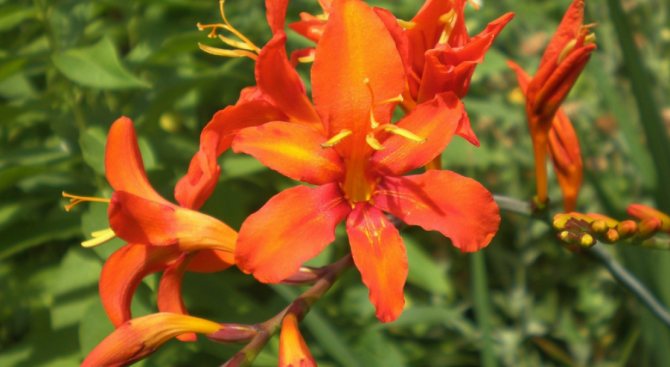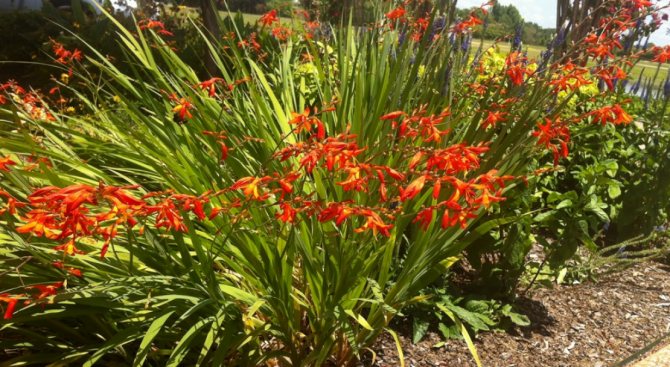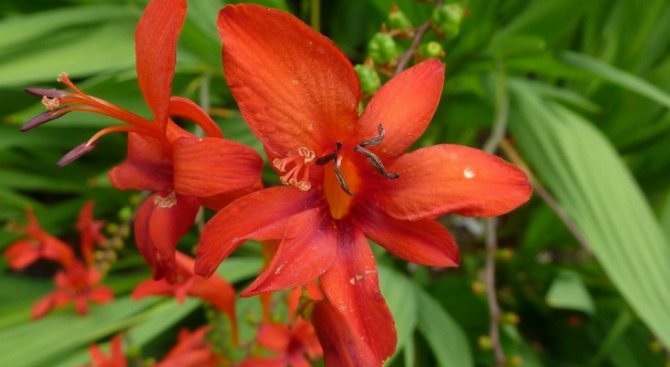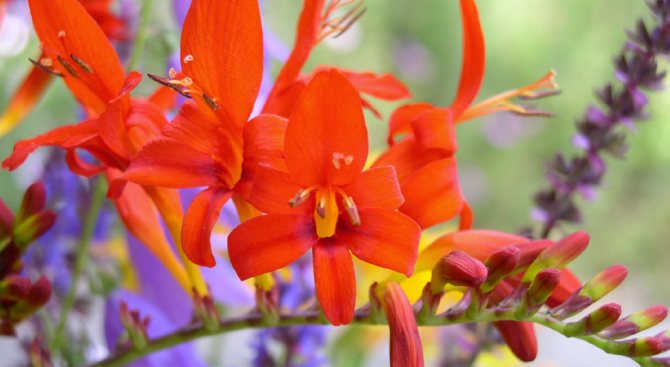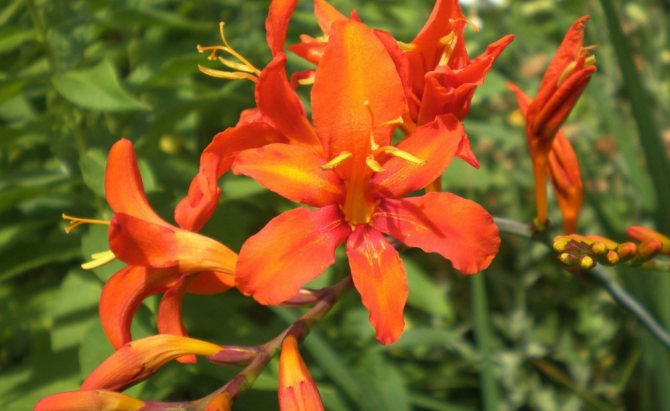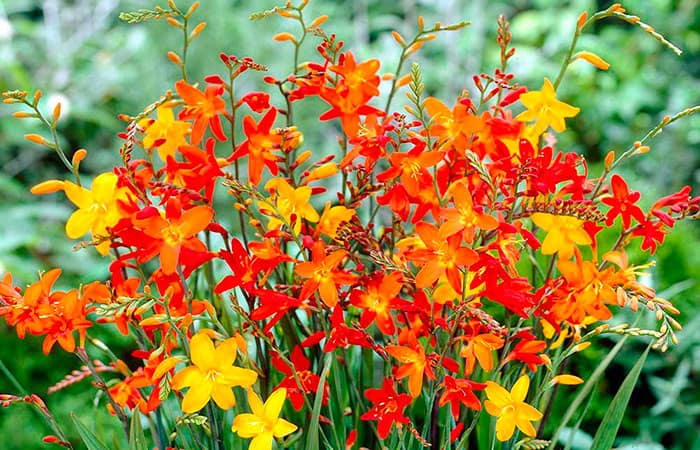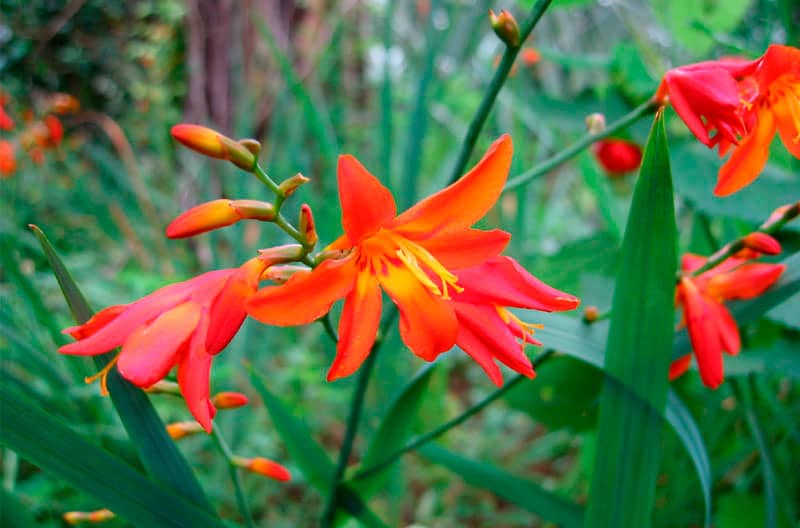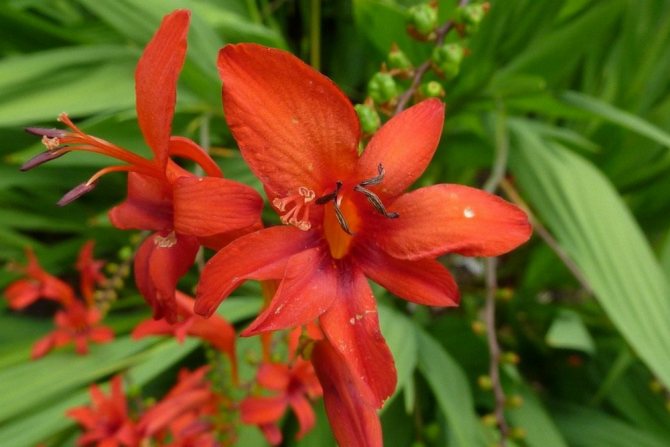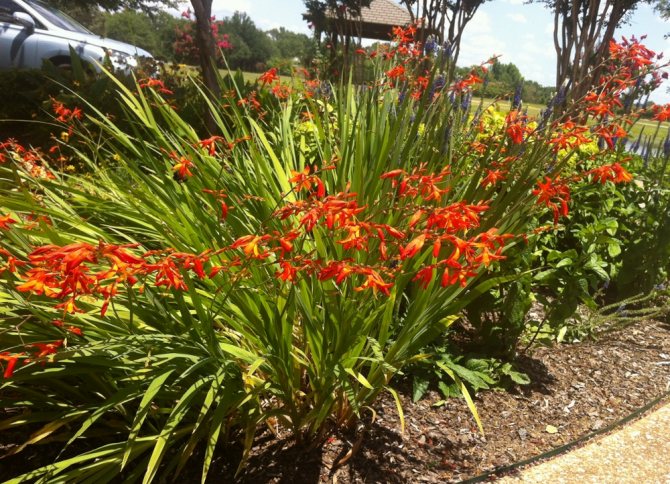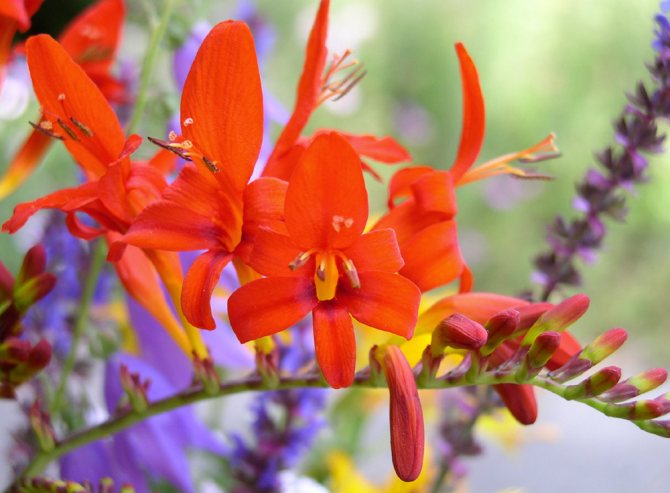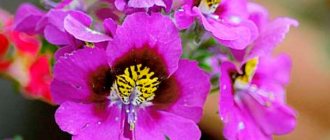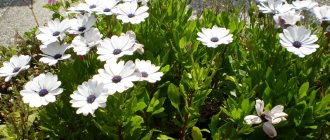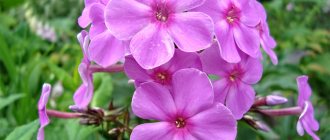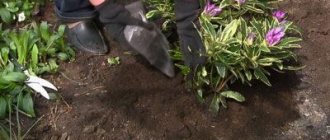Crocosmia (Crocosmia), or montbrecia (outdated name), or tritonia is a bulbous plant belonging to the iris family. Crocosmia consists of 2 Greek words: "kroros" - "crocus" and "osme" - "smell". The fact is that dried crocosmia flowers have a smell similar to that of saffron (crocus). And this plant was named montbrecia in honor of the Frenchman Antoine François Ernest Cockbert de Montbre, who was a botanist. Tritonia is translated from Greek as "weather vane", this plant is so called because of the inflorescence, which has a spreading shape. In natural conditions, such a flower can be found in southern Africa. In European countries, this plant has been cultivated since the 19th century.
Description of the plant
The birthplace of Montbrecia is South Africa. Despite the fact that the plant looks like a gladiolus, it belongs to the Iris family. The narrow leaves of the Japanese gladiolus are shaped like swords. Thin peduncles grow up to 1.5 meters. The first flowers, which have a rich color palette, can be seen already at the beginning of July. Dissolving in turn, they will delight you until September.
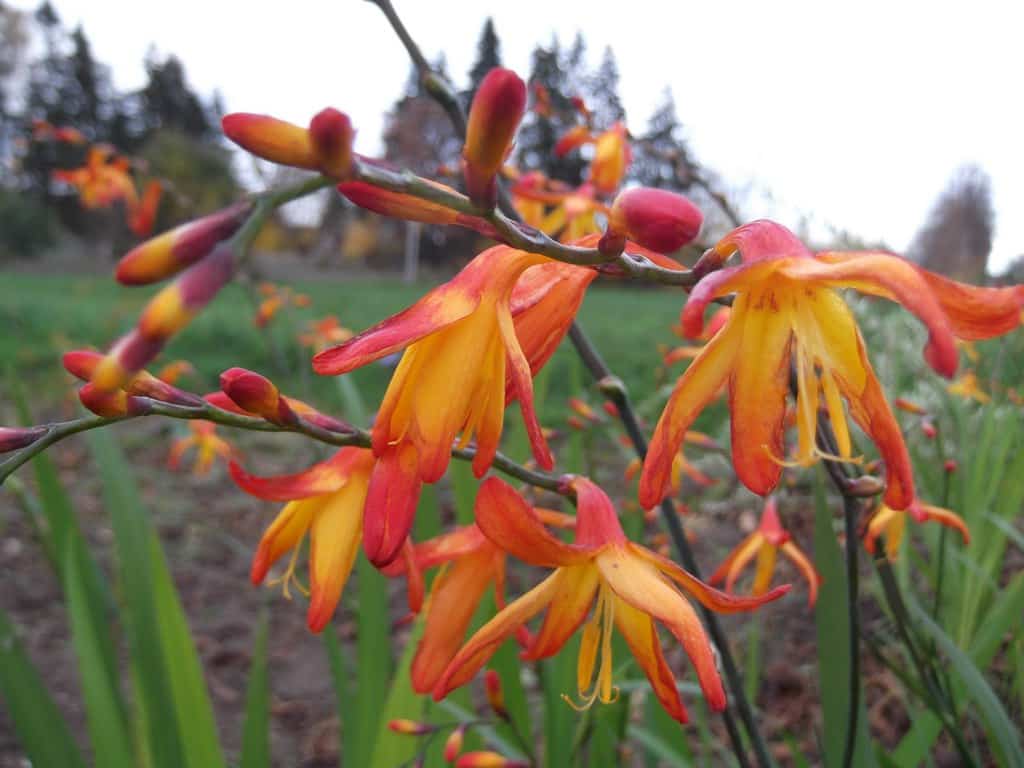
Common varieties
Among gardeners, the following varieties are most popular:
- The montbrecia is golden. The variety grows well in the shade, peak flowering in September.
- Crocosmia Masonorum. Peduncles of this variety reach 80 cm in height. Blooms mainly in summer, flowers are small.
- Montbrecia Panicula. A frost-resistant variety with corrugated leaves and bright orange flowers.
- Crocosmia Lucifer. Due to the huge variety of colors of this variety, it is used to create garden beds and beds.
Growing errors
Inexperienced gardeners often try to grow Japanese gladiolus by collecting flower seeds from a flower bed. But there are some nuances that gardeners should be aware of:
The seeds should be fully ripe and dry. The optimal time for collecting planting material is early October. Our climate does not always allow us to fulfill the necessary conditions. Wind and rain can simply destroy the planting material.
They sprout very badly. Only 10-20% of seeds will be able to germinate. Whether the seedlings will be able to survive in the future is also unknown. Because very often they are weak and unviable.
Therefore, the most optimal breeding method is to transplant children, which grow in abundance on the bush every year.
Planting and leaving
Planting Japanese gladiolus is carried out with bulbs. If they are old enough, then you can enjoy the beauty of a flowering plant this year. Unripe bulbs or babies will be able to bloom only after a year. Before planting in open ground, the bulbs must be prepared.
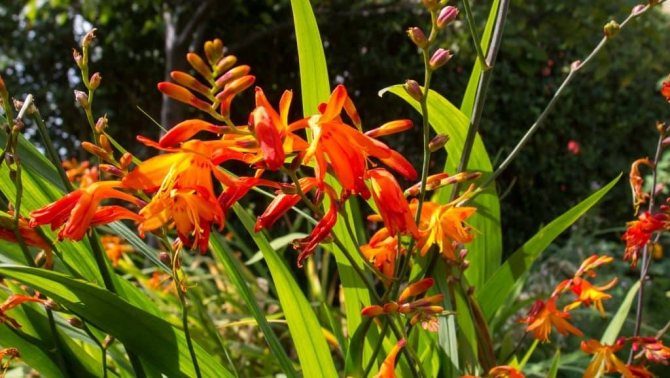

Material preparation
Planting material is taken from the basement a month before planting and stored at room temperature. If the nests are overgrown, then you need to divide them, cut off the remnants of roots and stems. Place the bulbs in a weak potassium permanganate solution before planting to stimulate growth, root formation and disinfect.
Choosing a site for planting
In order for the Chinese gladiolus, another name for this flower, to grow well, you need to choose a well-lit area.You can choose a place where the sun hits only for a few hours, as long as it is in the morning. With a lack of sunlight, the plant stretches, and the flowering becomes scarce.
The landing site should be as open as possible. Montbrecia is quite sprawling and its inflorescences hang above the ground, so a lot of space is needed. If you plan to plant it near the path, then step back half a meter.
Avoid windy locations. Air circulation is needed, but cold winds should not disturb the flower. Do not plant it in low areas where rain and melt water can accumulate. Stagnant moisture is detrimental to the plant, but it cannot be overdried.
Japanese gladiolus grows well in loose soil with high acidity. If you want to plant several varieties of crocosmia at once, then plant them away from each other so that there is no cross-pollination and the plants do not lose their decorative qualities.
Planting a montbrecia
Large bulbs should be planted deeper than all - from 8 to 15 cm, medium - from four to six centimeters. Children must first be soaked and germinated, they are sown into furrows no deeper than five centimeters.
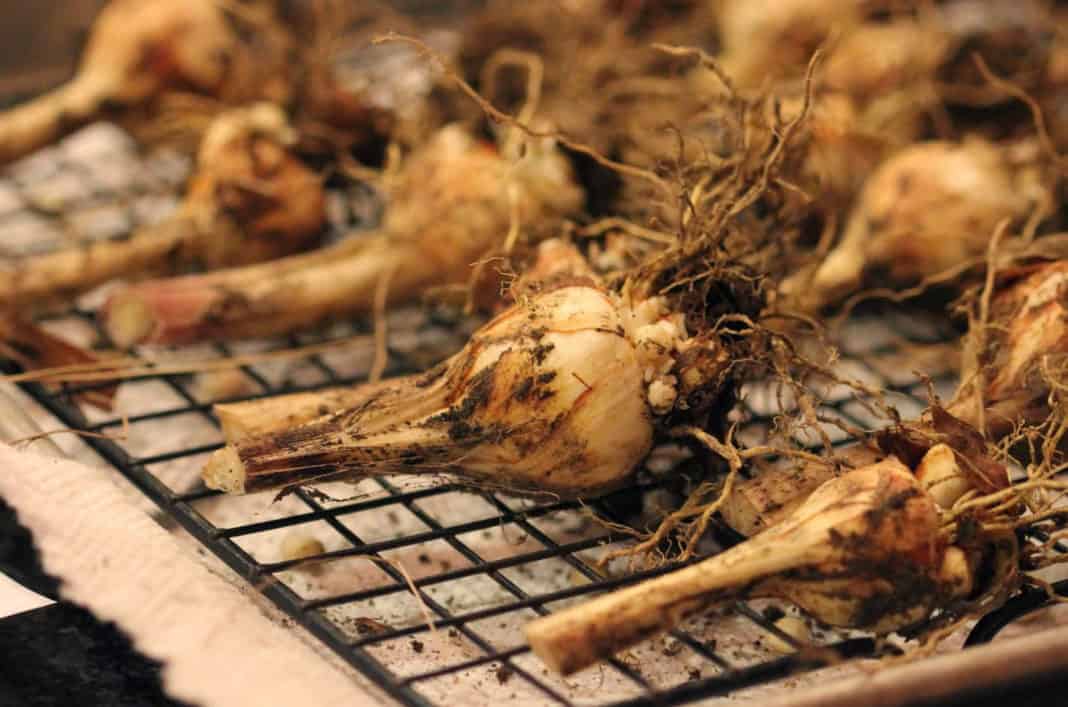

As I said earlier, it is necessary to plant the bulbs at a distance from each other, especially if they are of different varieties. If you want to see flowers a little earlier, then you can plant them in a pot and keep them at home, and then plant them in the ground with this earth.
Growing seedlings
To obtain seedlings, the bulbs are planted in spacious pots, pre-filled with a moist substrate. Which is used as sawdust or peat.
For this, the container is filled five centimeters with prepared soil. The planting material is distributed from above. The distance between the bulbs is small, three centimeters are enough.
The bulbs are covered with a suitable material to create a greenhouse effect.
Bulb care is completely standard, it consists in timely moistening of the soil and regular ventilation.
Do not allow the soil to dry out and the development of root rot. For better ventilation, it is recommended to make small holes in the covering polyethylene, if such a material is chosen to preserve the greenhouse effect.
When the sprouts hatch, separate containers with the soil mixture are prepared for the seedlings. Growing seedlings in pots should be two to three weeks.
With the onset of really warm weather, from about May 10, the seedlings begin to be transplanted into the beds. In different regions, the planting time is regulated by the local climate.
Nuances of care
Gladiolus is not a capricious or whimsical plant, so no special knowledge and skills are required in care. As a rule, the Japanese gladiolus needs timely watering, loosening the soil, weeding, feeding, hilling.
Watering
Regular but moderate watering is an important part of grooming. Avoid waterlogging, this will lead to rotting of the bulbs. Drying out of the soil is also unacceptable, as the flowers will wither and fall off. Watering should be adjusted based on the climatic conditions in your area. Check the condition of the soil before each watering; it should be slightly damp.
Development nuances
The Japanese gladiolus is a light-loving plant. It is important for this flower to choose a well-lit area when planting in the garden. For him, a long stay in the sun in hot weather is not scary, while for other plants it can be destructive.
If it is impossible to select a site in a brightly lit place for montbrecia, partial shade is also quite suitable. But a solid shade is not good for planting. In this case, the flowering will be very weak, the leaves and buds will be pale and inconspicuous.
The flower needs a lot of moisture. He is sensitive to watering, loves frequent water procedures - watering with rain from a hose.Thus, water enters the soil, and the leaves and stems are saturated with moisture.
But at the same time, you cannot fill the plant. Excess moisture in the soil can lead to root rot in the plant.
When caring for montbrecia, one should not neglect soil loosening and timely pruning. The trunk circle must be loosened every week. However, care must be taken not to injure the closely spaced roots of the plant.
When pruning, special attention is paid to removing the peduncles after flowering. This will stimulate the growth and development of the following flowers.


Preparing montbrecia for winter
Preparation of gladiolus for winter begins immediately after full flowering. We cut the bushes completely so that the bulbs ripen better. Most of the varieties are not capable of wintering in the open field, so the bulbs must be removed no earlier than October-November, so that they have time to fully ripen. An unripe bulb will not survive until next season.
All this must be done in dry weather. After digging up the gladioli, remove the leaves and stems, leaving the roots. Shaking them off from the ground and dry them for 10-14 days indoors. Cut off frost-resistant varieties at a level with the ground and pour a layer of mulch of 20-30 cm. Plants that survived the winter in the ground become strong, bloom profusely and for a long time.
Storage
Fold the gladiolus bulbs in boxes or cardboard boxes, sprinkle with dry peat or sawdust. They should be stored at a temperature not exceeding 7 degrees.
A bulbous plant, which, in addition to crocosmia, Japanese gladiolus, is also called montbrecia, is distinguished by a long stem, small flowers resembling lilies. At home, flowers practically do not take root, they like open ground. But can a novice florist be able to cope with the cultivation of these plants? Let's tell you more about the different varieties of Japanese gladiolus, planting and caring for them.
Care rules for Montbrecia
- Watering. Since Montbrecia prefers moist, but by no means swampy soil, it should be watered infrequently, but abundantly (once every 7-10 days). After watering, the soil must be loosened, weeds are removed.
- Top dressing. In the summer, it is recommended to feed the plant every 10 days with mullein infusion (1:10) and full mineral fertilizer (2-3 g per 1 liter of water), starting from the moment the second leaf grows. Potash fertilizers (2 g / l) are applied in the budding phase.
- Support installation. Peduncles of Montbrecia are long and slender. With a strong gust of wind, as well as from the severity of the inflorescences, they can break, and therefore pegs are installed nearby, to which the peduncles are tied.
- Preparing for winter. In the northern regions, Montbrecia corms are necessarily dug up for the winter. This should be done only in the second half of October. It is by this time that "children" grow and mature. The bulbs are dried in a well-ventilated room, after which they are transferred for storage to a place where they will not dry out and where the air temperature will constantly be kept no higher than + 10 ° C degrees.
Read also: How to make a florarium with your own hands, step by step instructions
If Montbrecia is grown in the southern and central regions, then the bulbs need not be dug up. Some gardeners claim that the bulbs can withstand temperatures up to -30 ° C, it is enough to sprinkle them with dry foliage or shavings with a layer of 20 cm in autumn, and then cover them with plastic wrap. In the spring, as soon as the threat of frost passes, the shelter is removed. Overwintered in the ground, Montbrecia is more powerful, blooms earlier and blooms longer.
Attention! Montbrecia overwinters without problems only in dry soil. If the corms are located in a lowland, where the groundwater is close to the surface, it is better to dig them up, otherwise the bulbs will get wet.In the spring, after removing the cover, all old leaves should be cut off. It is also worth digging out the corms every three years for the sake of reproduction. If this rule is ignored, the plants will bloom worse due to thickening.
- Diseases. With excessive soil moisture, drought, the plant can be affected by Fusarium. The disease can be determined by the fact that the tips of the leaves begin to turn yellow. The yellowness quickly spreads between the veins, the leaves become striped, turn brown and die off. If measures are not taken in time, the plant may die.
- Harmful insects. The danger of Montbrecia is thrips. During the flowering period of the plant, they are located in the inflorescences, suck out the juice, which leads to the drying of the flowers that have not yet blossomed. At temperatures less than + 12 ° C, thrips hide under the scales of the bulbs and hibernate there. Corms affected by thrips are covered with a sticky bloom of juice in winter and mummified. Naturally, in the spring they will no longer rise.
Description of the species
South Africa is considered the birthplace of Japanese gladioli. The corm hybrid was obtained as a result of experiments on crossing two varieties of crocosmia. Montbrecia is from the Iris family, although it looks more like a gladiolus.
The plant has narrow leaves with pointed tips resembling swords. Peduncles are thin, up to 1.5 meters high. The first flowers can be seen in early July. They, blooming in turn, delight flower growers until September. They can be painted in any color: from white to bright scarlet.
Features of crocosmia
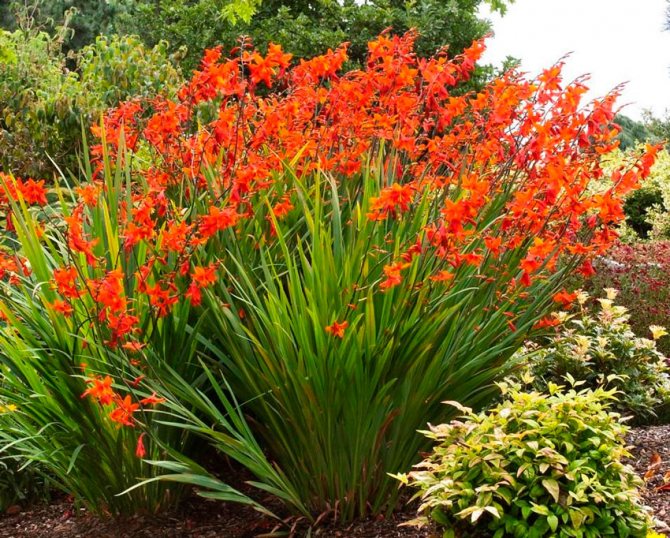

To date, cultural crocosmia is a bulbous herbaceous hybrid perennial, which is called common crocosmia. This hybrid was created by Lemoine in the 19th century, crossing the golden crocosmia and Potts crocosmia. The surface of the small tuber is covered with a reticular membrane. The height of this plant can vary from 0.4 to 1 meter. It has a branching stem, on which leaf plates of a xiphoid or linear shape are located. There is also a very strong peduncle, which gives the plant a resemblance to a gladiolus. In this regard, crocosmia is also called "Japanese gladiolus", while it must be grown in the same way as the gladiolus itself. The star-shaped flowers are colored white, orange and yellow, and in diameter they can reach 5 centimeters. Dense paniculate inflorescences consist of 3-5 flowers. The fruit is a round-shaped polyspermous capsule.
This plant is very closely related to popular flower crops such as iris, gladiolus, crocus saffron, ferraria and freesia. Crocosmia is most often used to decorate open flower beds, growing in conjunction with plants such as canna, salvia, daylily, rudbeckia and echinacea. This flower is also suitable for cutting, so its inflorescences can stand in water for up to a half moon.
Below it will be described in detail how to plant and grow crocosmia. And also a lot of useful and just very interesting information about this plant will be given.
The main varieties of Japanese gladiolus
Most often, flower growers grow the following varieties:
- The montbrecia is golden. The peak of flowering occurs in September. Better to grow in the shade.
- Crocosmia Masonorum. She has xiphoid leaves, large bulbs. It reaches a height of 80 cm. Small flowers appear in the summer months.
- Crocosmia Panicula. Not afraid of frost, can be distinguished from other varieties by corrugated leaves and orange flowers.
- Montbrecia Lucifer. More often than others, this hybrid variety is used to create beautiful beds in the garden. All because of the wide variety of colors.
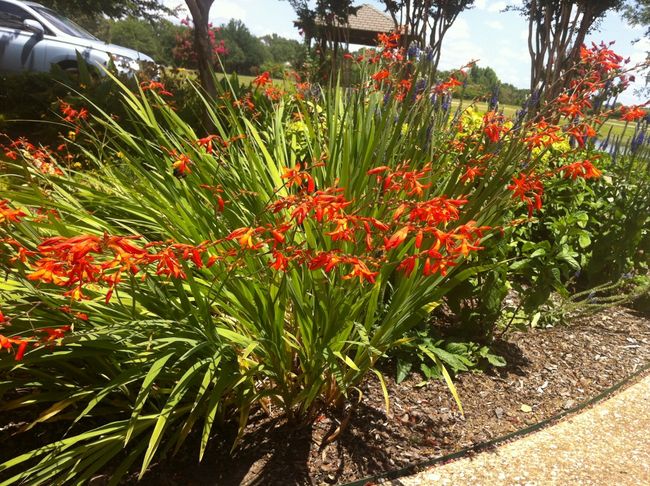

Types and varieties of crocosmia with photos
There are approximately 55 natural species of crocosmia. Below will be a description of the most common species cultivated by gardeners.
Crocosmia aurea
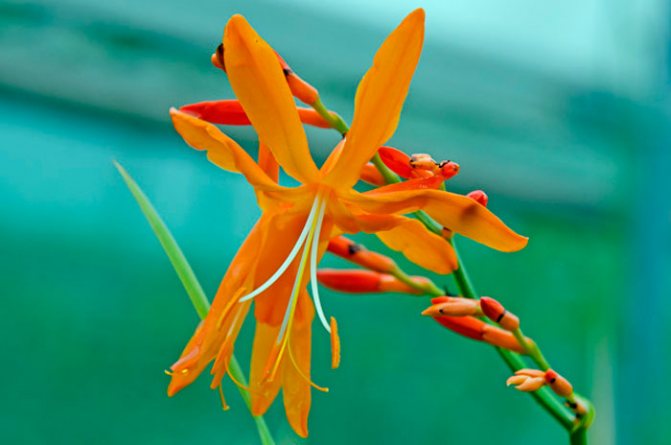

This species is native to the Republic of South Africa.The leaf plates have a xiphoid or linear shape, and the flowers have a rich orange-yellow color. Flowering in this species is observed at the beginning of the autumn period. It has been cultivated since 1846. There are several forms that have flowers of red, orange and yellow.
Crocosmia masoniorum
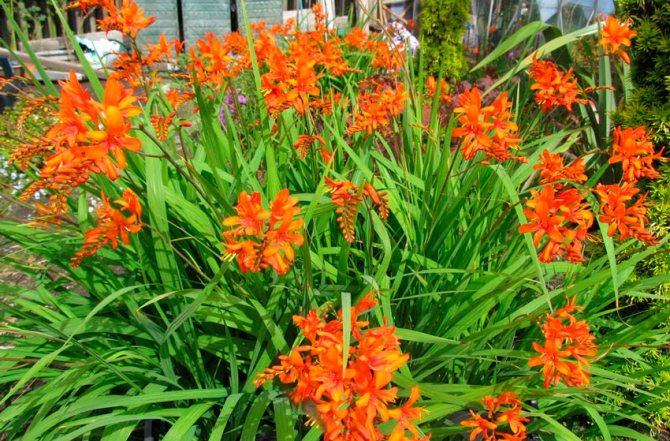

A compact bush in height can reach from 0.6 to 0.8 meters. Ribbed leaf plates of a xiphoid shape in width can reach 5 centimeters. The small flowers are rich orange in color, and they are part of the horizontal deviating racemose inflorescence. Flowering occurs in mid-summer. This species is the most frost-resistant in comparison with the rest.
Crocosmia paniculata


The species is tall, so the bush can reach a height of one and a half meters. The sheet plates are corrugated. This species is the earliest flowering, while flowering is observed in the second half of June. Small flowers of rich orange color are collected in panicle inflorescences.
Crocosmia pottsii


Under natural conditions, it can be found in Africa, while this species prefers to grow in swampy areas. In this regard, it is recommended to plant it in a shaded place, in which the soil will not dry out very quickly. The leaves of this species are narrow and smooth, the flowers are small in size.
Crocosmia ordinary (Crocosmia crocosmiiflora), or garden montbrecia


This plant belongs to the first crocosmia garden hybrids. It was created by Lemoine in 1880, while for crossing he used the golden crocosmia and Potts crocosmia. The height of the bush can be up to 100 centimeters. There are thin branched shoots, narrow erect leaf plates of a wide-linear or xiphoid shape and a pale green color. Small red-orange or yellow flowers are funnel-shaped, and they are part of paniculate inflorescences. Flowering is observed in July or August.
Breeding work on crocosmia is ongoing. So, more than 400 cultivars have already been created. The most popular ones are:


- Emily Mackenzie... The height of the compact bush reaches 0.6 meters. The upright arrows have a large number of brownish-orange flowers, which have a speck of bright color in the middle.
- Crocosmia Lucifer... The bush can reach a height of 150 centimeters. On its straight peduncles there are deep red flowers. This variety has a high frost resistance and if the winters are not too frosty in the region where it is grown, then the corms of such a plant can be left in the soil for the winter.
- George Davidson... The bush reaches a height of about 0.7 meters. Its amber yellow flowers look very impressive against the background of dark green leaves. This plant is great for cutting. Bloom is observed in July and August.
- Red King... The middle of deep red flowers is colored orange.
- Spitfire... The height of the bush can reach up to 0.6 m. Flowering is observed from August to the last days of September. The flowers are colored fiery orange.
- Tangerine queen... The bush can reach a height of 1.2 meters. The color of the flowers is rich orange.
Also excellent for decorating flower beds are such varieties as: Babylon, Golden Fleece, Star of the East, Norwich Canari, Mistral, Vesuvius, Bouquet Parfait, Lady Oxford, Reingold, Heath Magesti, Lady Wilson, Aurora, France Hals, Jace Coy, Lady Hamilton and etc.
Choosing a place for growing
In order for the montbrecia to bloom and grow well, a well-lit place is suitable. You can plant the plant in an area where the sun appears only in one half of the day. The main thing is that no shadow falls on the flower in the morning.If there is not enough light, the plant will stretch out, there will not be enough flowers. Montbrecia will not bloom without access to sunlight.
The planting space should be open, it is better if there is a lawn nearby. Crocosmia is quite sprawling. Usually, the inflorescences hang above the ground, so they need a lot of space. It is recommended to retreat from the path at a distance of about 50 centimeters.
Drafts must be avoided. Cold winds should not blow on the flowers, but good air circulation is essential. Lowlands, in which melt and rainwater are collected, are not suitable for montbrecia. Holding in moisture for this plant can be detrimental. It is believed that the plant is drought tolerant, but it should not be overdried.
Effectively growing montbrecia in loose acidic soils. It is better to plant different varieties of crocosmia away from each other so that they do not get dusty and lose their qualities.
Crocosmia in flower beds
The value of this plant is in its long and abundant flowering. From about mid-summer to September, luscious greens will favorably set off bright shades of red. Montbrecia in landscape design will be an excellent solution for a beginner, because the bushes are suitable for open flower beds and do not require complex maintenance.
- There is a variety for every region and taste. Emily Mc Kenzie is distinguished by its late flowering period, flowers are very bright saturated orange-red hue. The Star of the East variety will decorate flower beds until the first frost, suitable for cold regions. The height of the Lucifer bush reaches one and a half meters, it is used for landscape compositions in large open areas.
- The peculiarity of creating compositions is to prevent close proximity between different varieties. Cross-pollination is a major maintenance problem, but it shouldn't be difficult to solve.
- The place for the flower bed should be chosen light, because the brightness of the flowering will provide a sufficient amount of sunlight.
Read also: Stefanandra - planting and care Photo - ornamental shrub native to East Asia, growing Video
Planting a montbrecia
Montbrecia can be planted in two ways:
Bulb planting
For planting, choose medium-sized bulbs. If the diameter of the bulb is more than five centimeters, it is old, it is not recommended to use it for planting. The husks are removed from the bulbs, then kept warm for several days so that they dry out. Two hours before planting, they are placed in a potassium permanganate solution. It is better to prepare the soil in the fall. The beds are dug up, superphosphate fertilizer is applied (35 grams per 1 sq. M. Of the beds). If the soil is poor in nutrients, additional potassium chloride and nitrogen must be added. Sand is added to the clay soil.
In open ground, planting is carried out in the spring, no later than the beginning of May. It is necessary to check the temperature of the soil, it must be at least + 5 ° C.
A mixture is laid in each hole, which is prepared from compost, sand and peat. The substances are mixed in equal proportions. You should get a 15 cm layer. Onions are placed on it, which are sprinkled on top with sand and an earthen mixture. Planting is done to a depth of about ten centimeters when using large planting material, 5 cm if the bulbs are small. It is imperative to maintain the distance between the bulbs, about ten centimeters, and when planting different varieties of plants - about 80 cm.
Choosing a landing site
Montbrecia - not a very whimsical plant, but you need to choose a suitable place to grow it.
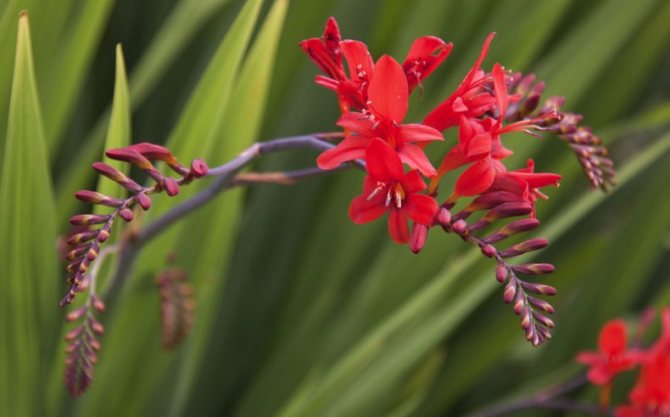

The plant loves light, but in the summer heat at noon there should be no sunshine. Planting in the shade is also not suitable for montbrecia - the flower will stretch, wither and may completely refuse to bloom.
Prefers loose, fertile, non-acid soils. Plant sensitively to excessive soil moisture and moisture stagnation. This leads to rotting of corms and their death.
If there is a danger of spring flooding, it is best to drain the hole before planting. To do this, it is deepened and covered by a mixture of sand and peat by 15–20 cm. Sprinkle humus on top and only then plant the bulb.
How to care for a montbrecia
Even a novice florist will be able to grow montbrecia, planting and care in the open field will not cause difficulties if the recommendations are followed. Water the plant two or three times. If the weather is very hot, it is worth increasing the frequency of watering, preventing the soil from drying out. To prevent a dry crust from forming on the surface of the soil, the soil is regularly loosened. Weed plants must be removed in a timely manner so as not to block access to the roots of oxygen.
Does Japanese gladiolus need fertilizers? Poor soil is a must. After the plant acquires two leaves, fertilizing with nitrogen fertilizers is carried out every two weeks (2 g per liter of water). In the summer, it is better to feed with a mullein, which is bred in water. After the buds appear, the plant needs fertilizers with potassium.
Crocosmia care in the garden
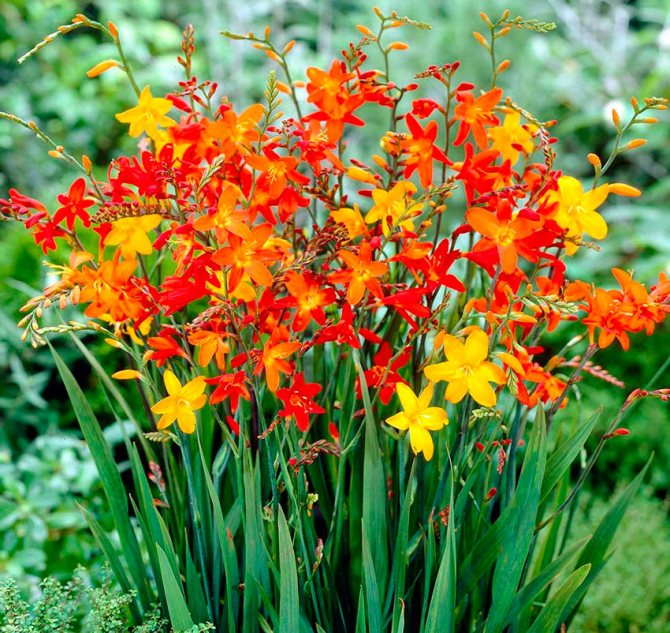

You need to take care of crocosmia in almost the same way as for gladioli. Watering should be abundant and carried out every 7 days. When the water is absorbed into the soil, it is recommended to loosen it to break up the crust that has appeared.
For normal growth and development, such a flower must be systematically fed. In the event that you planted crocosmia on nutrient-rich soil, then you can do without top dressing. But in the event that the soil is poor, then you need to start feeding the plants after the second true leaf is formed, while such a procedure is carried out with a frequency of 1 time per 1.5 weeks. For this, it is recommended to use an infusion of mullein (1 part of mullein is taken for 10 parts of water), as well as complete mineral fertilizer (for a liter of water, 2 grams of the product). During budding, such a plant needs a fertilizer containing a large amount of potassium.
Taking care of crocosmia is not at all difficult. As for diseases and pests, if you follow all the rules of agricultural technology, you will not have problems with this plant.
How to propagate
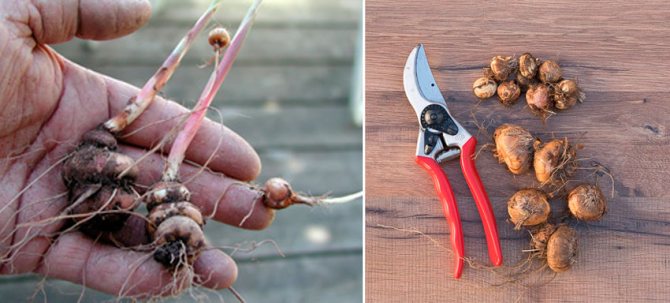

It was already mentioned above that such a flower can be propagated by seeds, and also for this they use a vegetative method. You can read about how to grow crocosmia from seeds above. For vegetative propagation, gardeners use the division of corms. Every year, about one adult corm grows to 5 children, which begin to bloom next year. At the same time, the parental corm continues to grow children. In this regard, when growing such a flower, it should be borne in mind that it will be systematically necessary to divide and plant the corms.
Division is usually done after the planting becomes very dense. To do this, in the spring, you need to dig up the corm and carefully tear off the children from the parent bulb, which are then planted in a permanent place. At the same time, it is recommended to plant children in the same time period as planting seedlings, namely, in the last days of April or the first days of May. If there is a desire, then for a start, the separated children can be seated in individual pots, where they will grow until May or June. And then they will need to be transplanted into open soil.
Pests and diseases
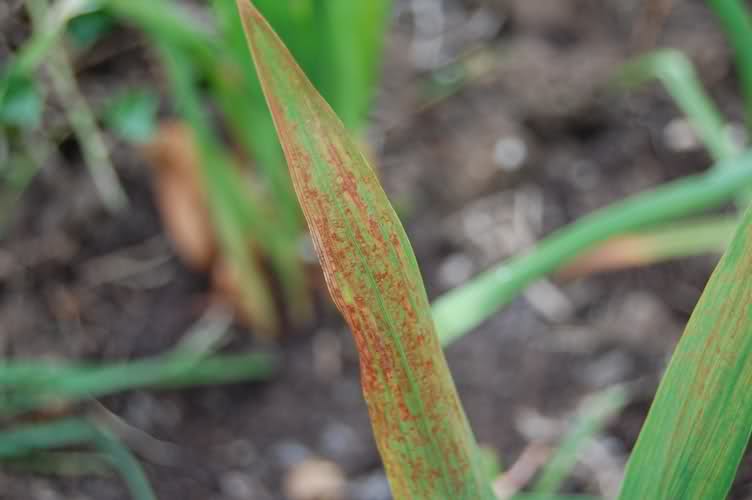

Crocosmia is highly resistant to diseases and harmful insects. But if you take care of it incorrectly or allow stagnation of fluid in the root system, then it can be affected by diseases such as:
Fusarium


In an infected bush, leaf plates begin to turn yellow, they gradually dry out and fall off. There is also a curvature of peduncles and deformation of flowers, while a change in their color is observed.
Gray rot
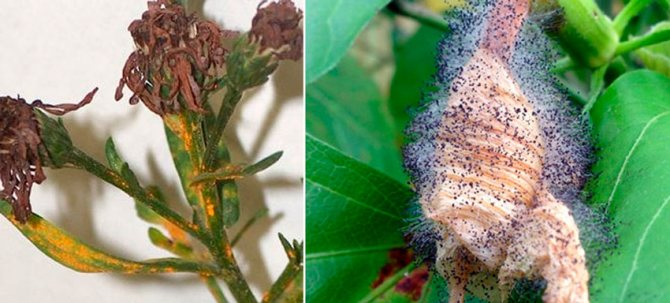

A fluffy bloom of gray color appears on the surface of the corms.
Herbiness (jaundice)
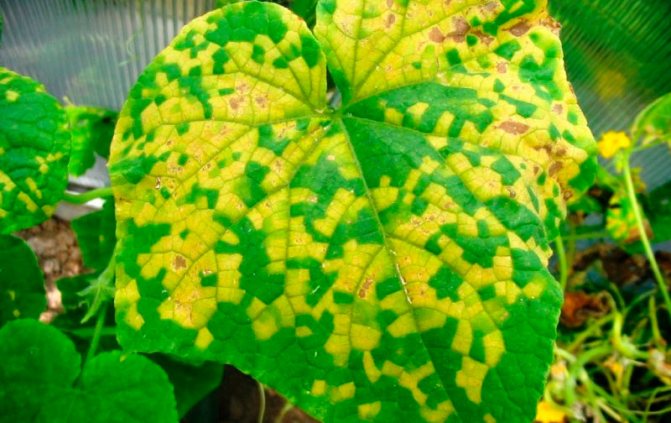

First, the tips of the leaf plates turn yellow, and then a straw shade appears on the leaves. As a result, the bush dies. This disease is viral, and it is carried by leafhoppers.
If the bush is infected with fusarium, then it should be treated with a fungicidal agent. It is recommended not to fight with gray rot, but to prevent its appearance. If the bush is struck by jaundice, then it will be impossible to cure it, because an effective remedy has not yet been found for this kind of disease. For preventive purposes, in order to prevent infection of crocosmia, it is recommended to plant it exclusively according to the rules of agricultural technology. Also, before sowing or planting, it is necessary to process the planting and seed material with a solution of potassium manganese (1%) before sowing or planting. You also need to systematically change the planting site of such a plant.
Crocosmia can be especially affected by such harmful insects as: thrips, bears, and even spider mites.
Medvedki
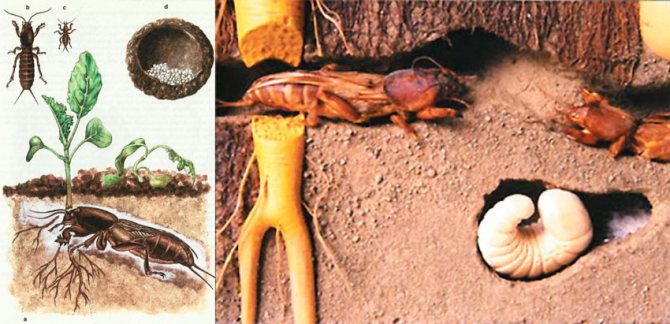

Such insects eat corms, and they lay offspring in the ground at a depth of ten centimeters. In order to destroy them, it is recommended to make special traps. At the beginning of the autumn period, you need to dig a hole half a meter deep and put fresh horse manure in it. In order not to forget where this place is, put a pole. After some time, bears in the soil should settle in the manure for the winter. You just have to dig a hole and destroy them.
Thrips
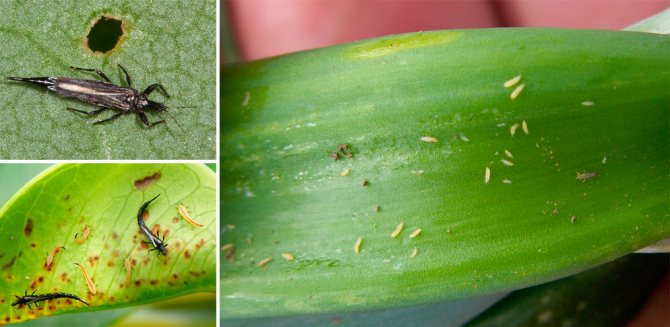

They suck vegetable juices from crocosmia. In the affected specimen, discolored specks, stripes or streaks form on the leaf plates. Shoots become crooked, leaves fall off, and flowers become less attractive. To get rid of such insects, you should process the bush with such means as: Fitoverm, Karbofos, Agravertin, Actellik or Confidor, while you must follow the recommendations given in the instructions.
Spider mites
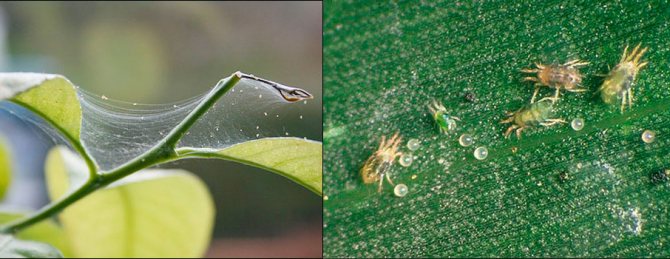

They only settle on plants during long periods of drought. These pests also suck out plant juices from the flower. It should also be remembered that such pests are carriers of viral diseases that cannot be cured. To destroy such insects, you should use the same drugs that are recommended for the fight against thrips.
Montbrecia care in winter and autumn
How to care for crocosmia in autumn? As soon as the plant has faded, you need to cut off the ground parts, this will help the bulb to ripen. For the winter, montbrecia is not dug in warm areas. Only carry out mulching with leaves, spruce branches or dry sawdust, spreading them with a 20 cm layer. From above, everything is covered with foil. In this case, the montbrecia bulbs are dug up only once every few years in order to remove the babies.
In areas where winters are harsh, the bulbs are dug up and dried in the air. It is best to use containers filled with peat or sand for storage, store the bulbs at +8 degrees. If there is no other suitable place, you can wrap the bulbs in paper and put them on the bottom of the refrigerator.
Some growers advise to leave several bulbs in the ground even in cold weather. Not all will survive, but those specimens that overwinter will be well hardened. In summer, they will throw out good stalks with an abundance of flowers.
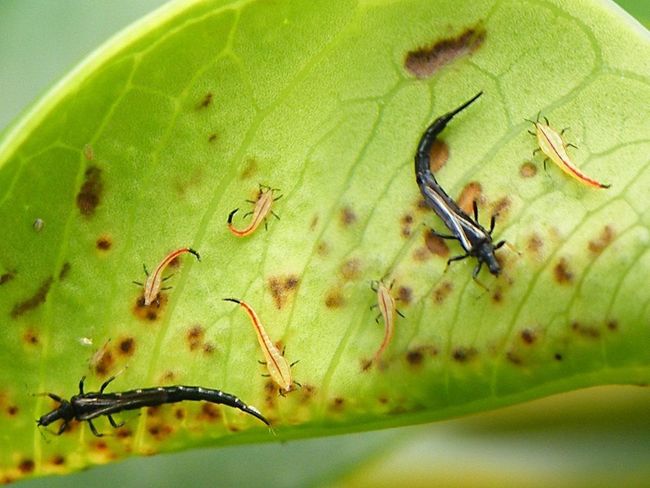

Care Tips
Caring for a plant consists of quite common activities: weeding, feeding, garter, winter preparation and pest control. When planting corms in soil that has been well fertilized in advance, caring for it throughout the summer is minimized.
Watering, weeding and loosening
It is worth watering this plant abundantly, but not often. Waterlogging of the soil must not be allowed.If the weather is not dry, the plant is watered 2 times a week, if it is hot, the montbrecia should be watered 3 times more often. After watering, the soil is weeded and loosened so that an earthen crust does not form.
Fertilization
Feed crocosmia before flowering 2 times a month with nitrophosphate and mineral fertilizer, which includes nitrogen, potassium and phosphorus. During the formation of buds, potassium chloride is introduced, and the plant is watered with mullein infusion twice a month.
Garter to support
Sometimes the flower needs to be tied to a support. This is done in cases where the montbrecia is very high and grows in an open place where the wind can break it.
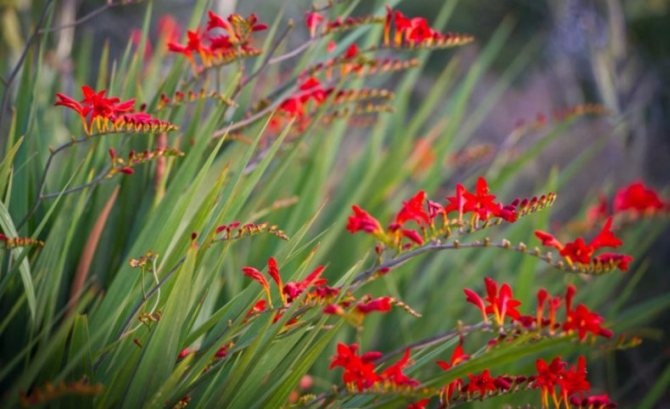

Pruning faded peduncles
It is necessary to cut off flowers that have faded in time. This is necessary to increase the decorative effect of the montbrecia and accelerate the ripening of the bulbs.
Fight against possible pests and diseases
Bears and thrips are the main pests of montbrecia. To combat them, special chemicals are used, such as Fitoverm, Karbofos or Medvetox. The plant must be sprayed at the dosage indicated on the manufacturer's packaging.
The flower is susceptible to diseases such as dry rot (fusarium) and grassiness. Such diseases are the result of drought or high humidity.
The leaves turn yellow and then wither. To combat, it is necessary to heat the bulbs and spray the flower regularly. It will only help if the situation is not too overwhelmed.
For the winter, the Japanese gladiolus can not be dug out, if the climate permits. It is covered with a thick layer of dry leaves about 20 cm high. And the flower is also covered with a film to protect it from dampness.
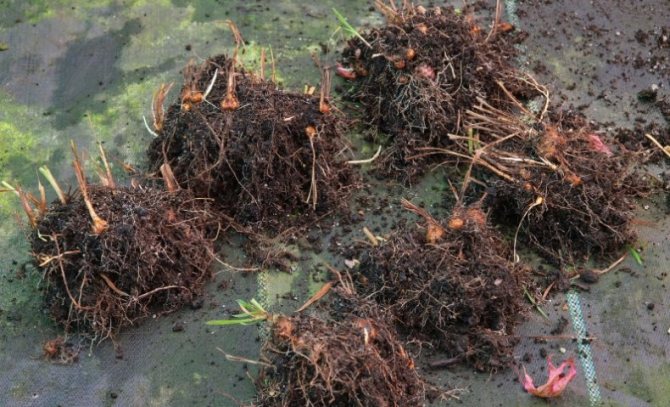

It is better to dig up varietal montbrecia for the winter. This is done at the end of October in dry weather. Then you need to cut off all the stems, leaving 5 cm. The plant is dried, laid out in a box and sprinkled with peat. Monbrecia requires storage in a cool, dark place during the winter, where the temperature will not exceed 10 ° C.
Pest and disease control
- If the leaves dry, the stem has become hooked, we can talk about fusarium, a fungal disease. Fungicides will cope with the disease.
- The main sign of grassiness is drying foliage. This virus is carried by leafhoppers. The only way out is to remove the plants and burn them.
- Gray rot appears with abundant watering. With a decrease in the frequency of watering, everything will return to normal.
- When thrips attack, flowers begin to fall off, spots appear on the leaves. It is necessary to process the plants with Confidor, Karbofos.
- Bears infect the bulbs, spoiling them. In order to get rid of pests, you need to pour manure into the dug hole, the bears will settle in it for the winter. In late autumn, you can easily destroy them.
- If the leaves fall heavily, a spider mite may be the cause. Insecticides have a destructive effect on the tick.
Following our simple recommendations, you can grow magnificent Japanese gladioli, which will delight the eye with their beautiful flowers for the whole summer.
Chinese, or Japanese gladiolus, also known as montbrecia or crocosmia, is a beautiful and unpretentious plant that will adorn any garden. The main advantage of this unusual plant is that it blooms from early summer to late autumn, depending on the variety. The variety of shades is impressive too. Crocosmia can bloom in bright scarlet, yellow or orange flowers. However, in order for the gladiolus to take root well and delight with its unusual appearance, it must be planted, observing certain rules. The same goes for leaving.
Combination with other plants
Montbrecia looks great in any flower garden and is combined with any plant. Basically, it is planted in the first or second row in large groups. Blooming crocosmia, along with dahlias, daylilies, rudbeckia, salvia, cannes and other flowers, fascinates with its colors.
Read also: Diana climbing tree-nose: planting and care
Long green leaves can dilute any composition... For landscape design and decoration of territories, the Japanese gladiolus is an irreplaceable plant. High grades of crocosmia will help decorate the aged walls of buildings and gazebos.
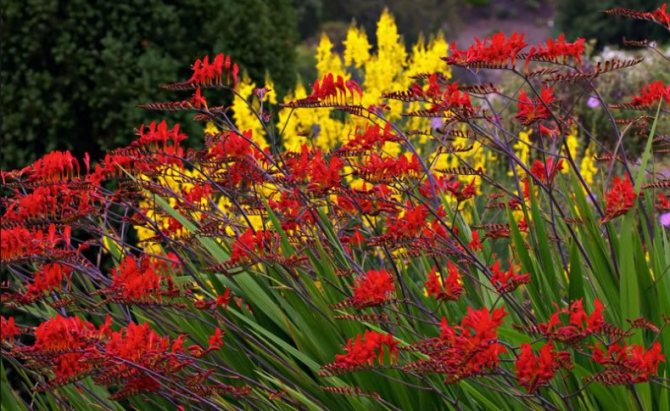

Description
The homeland of crocosmia is not at all in China, but in South Africa. The plant belongs to the iris family. "Crocosmia" in Greek means "saffron scent", as its dried flowers smell of this noble spice. And the garden Chinese gladiolus was bred by Lemoine, a breeder from France. The plant is sometimes called the Chinese gladiolus.
For the Japanese gladiolus, the flowers are star-funnel-shaped, collected in the form of multi-colored spikelets. Crocosmia looks great not only in the garden, but also in cut form. Flowers can stand in a vase without losing their charm for up to two weeks. Crocosmia looks great in combination with an asparagus sprig. Winter bouquets of dried montbrecia are unusual and original.
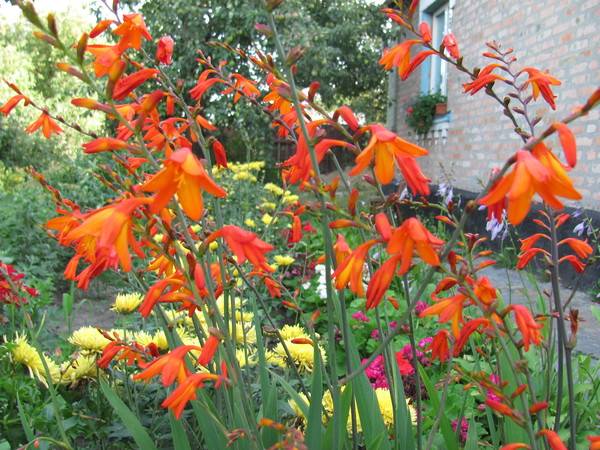

Where and how does Japanese gladiolus grow?
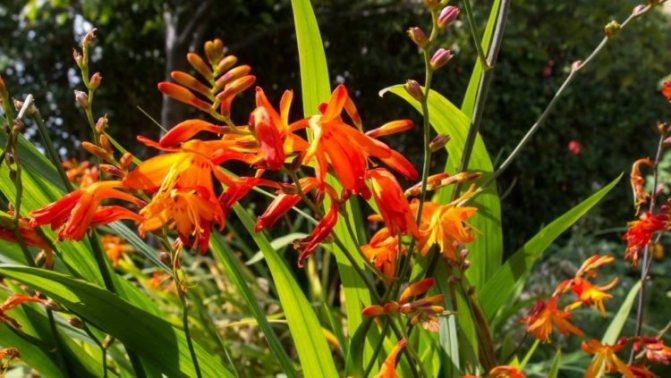

The birthplace of montbrecia is the southern and central part of Africa, where it grows in natural conditions of a humid subtropical climate, forming whole thickets. Therefore, planting sites should be well lit, with sufficient soil moisture.
If you dig a plant together with a lump of earth in early autumn and plant it in a flower pot, then it will delight you with flowering on a windowsill or a glassed-in balcony for even more than a month.
Reproduction methods
There are two standard breeding methods for montbrecia.
Seeds are sown in February-March by placing the pots in a well-lit place. By May, crocosmia grows, and it can be planted in a garden bed with a clod of earth to better take root. If you are going to plant crocosmia in pots, then this can be done in the month of April. Naturally, gladioli from seeds will not bloom right away. Flowers appear in the second or third year.
Immediately before planting in the soil, the bulbs must be kept for 2-3 days in a warm room. About 2 hours before planting, the bulbs should be soaked in a pale pink solution of potassium permanganate. Planting depth is 5 cm.
The bulbs are planted at intervals of 10 to 12 cm. To get flowers faster, plants grown in pots are planted.
Japanese gladioli grow well in lighted areas with low groundwater. It is important that rainwater does not stagnate in the area. If you plant a montbrecia in a poorly lit area, then it may not bloom.
Winter care
The flower tolerates winter drops in temperatures. But at the beginning of the life cycle, it is important to provide him with protection from the cold.
There are two ways to keep montbrecia in the winter: the bulbs are dug up and stored in a dry and cool place, or they are left in the soil for the winter.
These nuances are determined by the winter subzero temperatures in the area. During very harsh winters, when the ground freezes deep enough, it is better to store the bulbs in a suitable room.
In this case, the bulbs are dug out before the frost begins. For the winter, the montbrecia is placed in pre-prepared boxes, covered with a thick layer of fresh sawdust. It is only necessary to exclude the ingress of insect pests into this substrate, which can damage the bulbs during wintering.
Throughout the winter, planting material must be kept at a temperature of about 7 degrees, in a dark room. A cellar or cold storage room is very suitable for this purpose.
The main thing is not to forget about humidity. For this, the substrate is periodically sprayed with water, after taking out the bulbs. Because dried out bulbs will no longer be able to germinate.
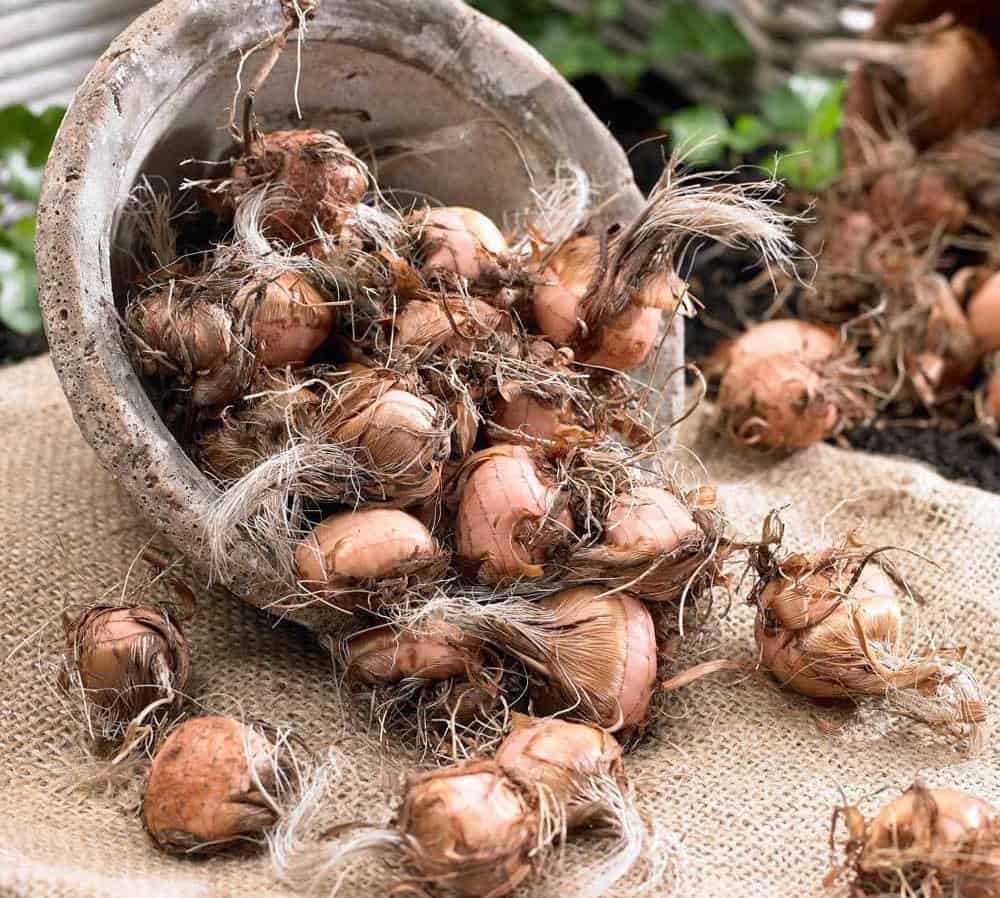

In our mid-latitudes, the montbrecia overwinters in the soil, but it should be provided with a cover with a thick layer of suitable covering material. The soil around the bush is shallowly dug up and then mulched.Dry sawdust or dry foliage can be used as mulch.
For greater reliability, the bush is covered with a piece of roofing material.
How to grow gladioli
Chinese crocosmia does not need frequent watering. After watering or rain, the soil must be weeded and loosened. Nitrogen fertilizers accelerate the growth of Japanese gladiolus. In the summer, you can use a mullein solution in a ratio of one to ten. Organic fertilizers can be used in parallel with potash mineral supplements.
In late autumn, when the gladiolus completely fades, the stem must be completely cut off. This is done to make the bulbs ripen better. This measure helps the corms to successfully endure the winter in the soil. If the region has a harsh climate, then the bulbs need to be dug up closer to the onset of winter cold weather.
Planting material is stored at a temperature of no higher than 10 degrees, avoiding drying out. Corms are well stored in a wooden box with sawdust. It is only necessary to first check that the sawdust is not affected by the woodworm beetle. To prevent the bulbs from drying out, they are pre-moistened with a spray bottle. In warmer climates, bulbs also overwinter in the soil. If, according to forecasts, the winter is going to be cold, then the tubers are covered with a 20-centimeter layer of leaves, and on top of them - with polyethylene. This protects the bulbs from freezing the soil. In the spring, all that remains is to remove the film and rake the leaves.
The plant is resistant to diseases, it is not difficult to grow it, but pests like thrips and bear are dangerous for it. Therefore, if you want to have beautiful, healthy and intact plants on the site, destroy them.
Crocosmia after flowering
Seed collection
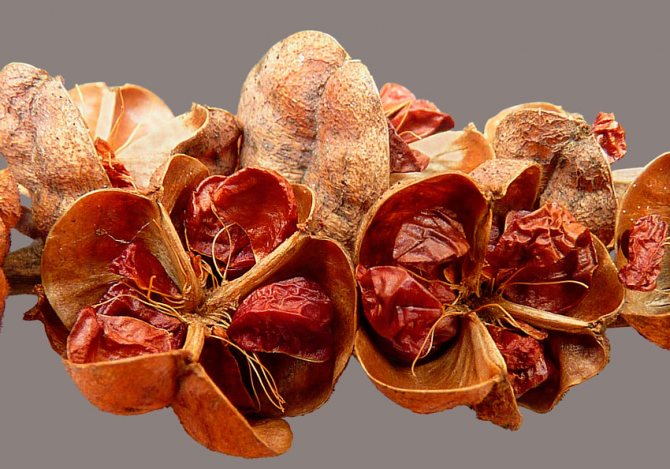

In the event that you already have crocosmia growing, then it makes no sense to collect its seeds, since it is much easier and more efficient to propagate such a plant by dividing the corms. And in order to grow such a flower through seedlings, it is recommended to use seeds purchased at the store.
How to prepare for wintering
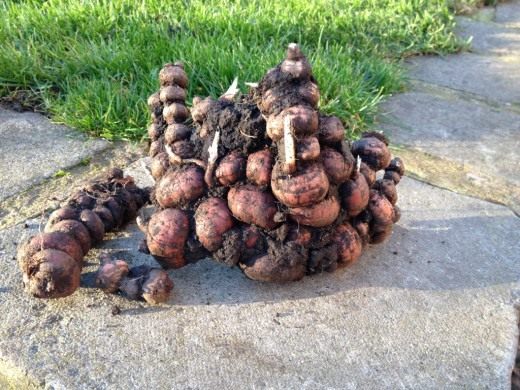

If you grow crocosmia in a region with frosty winters, then it is recommended to extract the bulbs from the ground in autumn. It should be borne in mind that they must be dug out no earlier than the second half of October, otherwise the children will not have time to form normally. Corms should be thoroughly dried, while placing them in a cool (about 10 degrees) room with good ventilation. They should be stored in the same way as gladiolus bulbs.
In the event that crocosmia is grown in a region with mild winters, then it will not be possible to dig it out for the winter. However, in autumn, the site will need to be sprinkled with a layer of mulch, while wood shavings, spruce branches or dried leaves are placed on it.
If the cultivation takes place in the southern region, then the site can only be covered with dried leaves in autumn, while the layer thickness should be about 20 centimeters. A film is laid on top of the leaves. When the frosts are left behind, the shelter will need to be removed, while cutting off the old sheet plates to the ground surface.
Overview of common varieties
The most popular crocosmia varieties are as follows:
EmilyMcKenzie
Ornamental plants with flowers of a brownish-orange hue, collected in a symmetrical spike. There are red spots in the center of the petals. The height of the plant is 60 cm. The gladiolus blooms late.
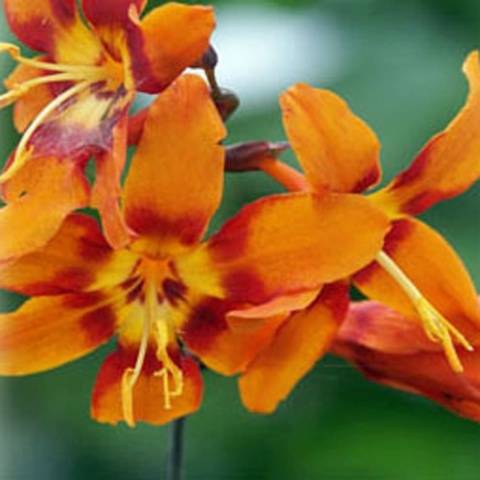

3
Norwich canary
60 cm plant with yellow buds.
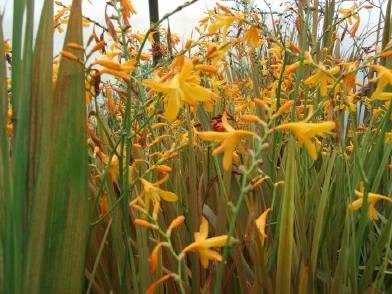

"Star of the East"
This variety is considered one of the most popular among montbrecia, because of its unusually large and beautiful flowers. The bud is orange in color, has a star shape. Its diameter is about 10 cm. The plant is tall. Its height is about 1.0 m.
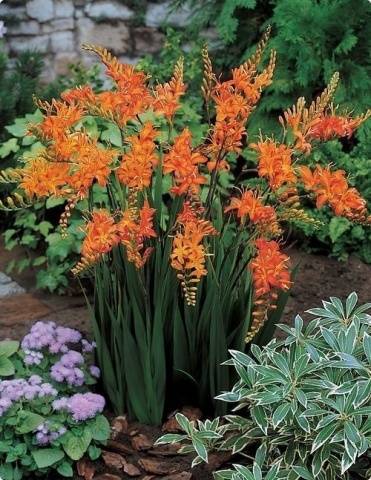

Lucifer
This variety is rightfully considered the brightest. The flowers are very beautiful, with a bright scarlet hue.The plant is tall (it so happens that it has grown about 1.5 m), with a stable erect stem.
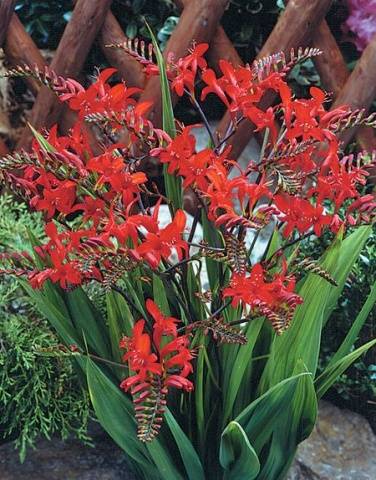

Paniculate crocosmia
The variety is distinguished by early flowering (the first flowers appear in the month of June). The plant blooms very profusely, with bright orange flowers.
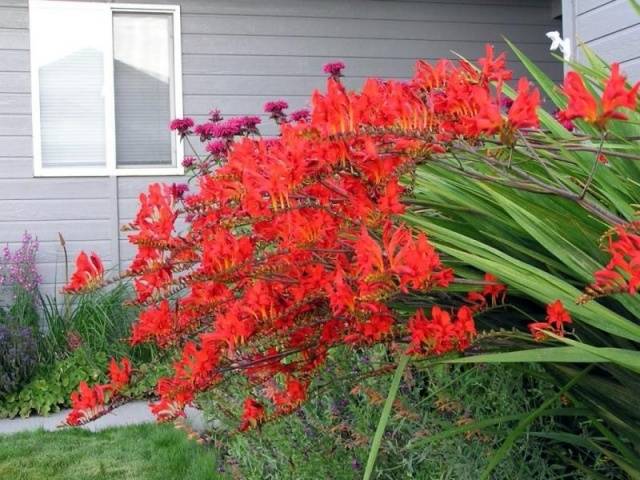

The benefits of the plant
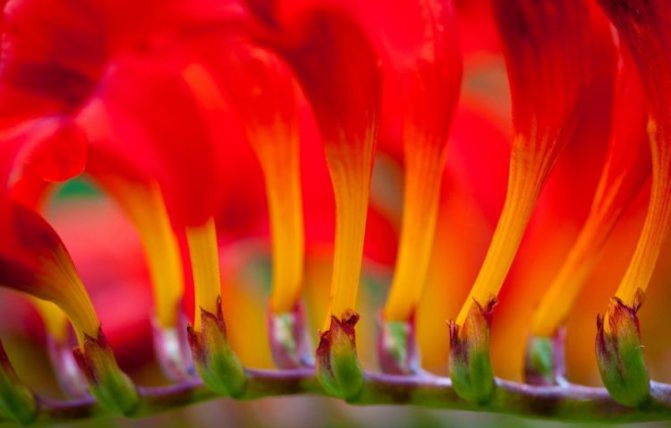

The only useful property of montbrecia is its decorative effect. It is bred not only for the sake of beautiful flowers, but also for the sake of pleasant-looking greenery. For 2-3 years, montbrecia grows well and is used as a ground cover plant. You can plant it even in dense shade - it is unlikely to bloom there, but dense emerald thickets will decorate your site.
In addition, montbrecia is good for bouquets - cut flowers retain their beauty and freshness for up to 2 weeks.
Success secrets
Crocosmia is quite unpretentious in cultivation. An important condition for normal growth and long-term preservation of flower buds is the maintenance of soil moisture. At the same time, it is important to prevent stagnation of moisture in the ground.
For optimal growth, provide the crop with plenty of light and regular fertilizing in the form of mineral fertilizers and organic fertilizers.
Crocosmia does not tolerate foliage pruning, so you should be careful about pruning after flowering or in the fall. Pruning can damage the tubers. Yellow and old leaves are removed in spring.
Growing and caring for Chinese gladiolus
Planting and caring for a montbrecia involves moderate watering and weeding of the soil after rain so that the soil is airy and does not clog the plant. To accelerate the growth and flowering of Chinese gladioli, they can be fed with nitrogen fertilizer or tincture of cow dung. In addition to organic fertilizers, mineral fertilizers containing potassium are also suitable.
After the bud is fully blooming, it is necessary to trim the stem almost to the very base so that the bulb is saturated with useful substances before the onset of cold weather and better tolerates frosts in the ground. If the climate in winter is rather harsh, then the bulbs must be dug out before the onset of cold weather, and in the spring they must be planted in the ground. Store the bulbs in a basement or pantry where the air temperature does not exceed 8 °. If it is impossible to predict the season, then for safety reasons, the bulbs wintering in the ground should be covered with a thick layer of fallen leaves and a film should be put on top. In the spring, the film and foliage are removed so that the flowers make their way through the soil at the right time and delight in the summer with a beautiful view.
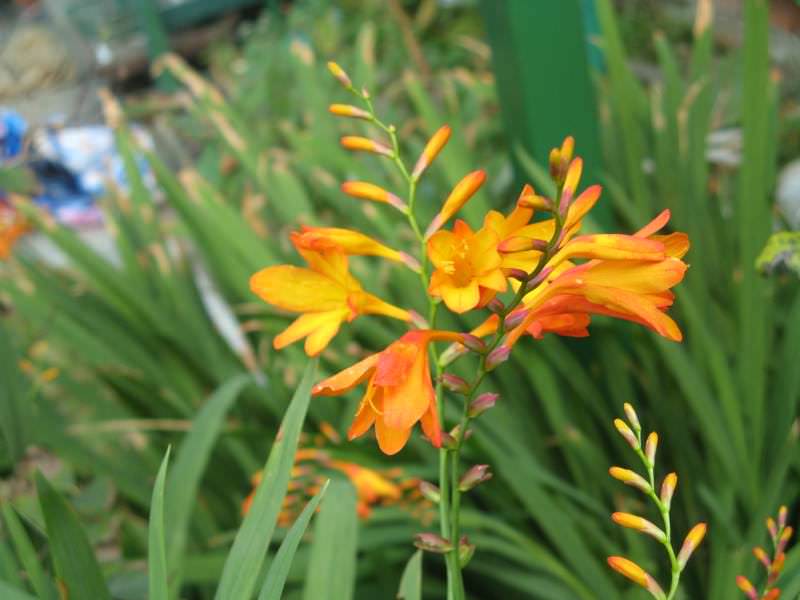

Gladioli, whose bulbs have been in the ground for more than 3 years, may grow worse and bloom less. To prevent this from happening, it is necessary to dig up the bulbs once every 3 years and plant them again in the spring. This will help propagate the plant with the bulbs and their babies so that you don't have to grow the flowers from the seeds again.
Chinese gladiolus is resistant to many diseases and pests. The only ones that pose a danger are the bear and thrips, which can negatively affect the growth and flowering of the plant. If pests are noticed, you will need to purchase a special product and process the flowers.
And a little about secrets ...
The story of one of our readers Irina Volodina:
Especially depressing for me were the eyes, surrounded by large wrinkles plus dark circles and swelling. How to remove wrinkles and bags under the eyes completely? How to deal with swelling and redness? But nothing makes a person look older or younger than his eyes.
But how to rejuvenate them? Plastic surgery? Recognized - at least 5 thousand dollars. Hardware procedures - photorejuvenation, gas-liquid pilling, radiolifting, laser facelift? Slightly more affordable - the course costs 1.5-2 thousand dollars. And when to find all this time? And it's still expensive. Especially now. Therefore, I chose a different way for myself ...
Read the article >>
A surprisingly beautiful crocosmia plant will be able to compete with many bulbous plants.The flower, whose homeland is South Africa, has long been grown in the gardens of our country. Its bright green leaves appear at the very beginning of spring, and in summer crocosmia adorns the garden with its beautiful flowers with a warm range of shades. The plant is unpretentious to care for, but planting and growing it requires adherence to some recommendations.
Planting gladioli
The bulb should not be large, it is usually medium. You also need to pay attention to the bottom, if the bottom is small, clean, then this is the most important bulb, it needs to be opened further. We clean the husks, and it is important to look at the sprouts, if, for example, there are not two sprouts, then you will have two peduncles. One will accordingly be larger, the other slightly smaller, then the bulb will split. There are bulbs, more elongated, the same attention should be paid to the bottom of the plant and the root. The gladiolus bulb has three parses. The parameters are the diameter and height of the bulb. The first analysis includes bulbs with a diameter of 3, 2-3, 5 cm.In the second analysis, they should be from 2.5-3.2 cm.And the third analysis is 1.5-2.5 cm in diameter. those bulbs are considered whose diameter is more than 4.4-5 cm. An old large onion, it can already be said, is not a planting one, firstly, because it is productive for only four years, then it becomes thinner, its bottom expands, with such bulbs can only be seeds collected and planted, but they can bloom only after a year, they are grown separately, they also need care. Also, you can buy only one onion and multiply it without waiting for the "kids" to grow on them. The gardener sprouts it, there are 5-6 buds on it, you can make an incision so that there is a bud and the bottom, treat the incision with coal, and then you can plant it for reproduction. The gladiolus has a two-tiered horse system. The root system of the mother planting bulb grows for the first time. And then a root system is formed between the mother and the replacement bulb, already when the “babies” are growing. The root system of the bulb grows until flowering occurs. Once flowering has begun, the root system stops growing. As soon as the ground warms up on the bayonet of a shovel, the weather is good, it's time to plant gladioli, in an easy place, in structured soil. Plant where flowering will delight your dawn. And try to bury the bulbs as deep as possible, 12-15 cm, quite enough, for a large onion, 8-10 cm, for a medium one. You can plant gladioli in a row, or you can scatter them in groups around the site, or you can plant them in a checkerboard pattern. When planting, keep in mind that gladioli will need to be tied up, sprinkled with earth and watered so that the water does not drain. For the entire growing season, do 3-4 root dressings. Gladiolus is fed up to the peduncle arrow, nettle infusion or special universal fertilizer. And when the peduncle appears, you can fertilize with phosphorus fertilizers or infusions. It is recommended for gardeners to process gladiolus planting material with garlic infusion. It is recommended to use hot water for thrips, but since the sprouted onion cannot be soaked, only if it is not yet sprouted, then only in this case hot water can be used.
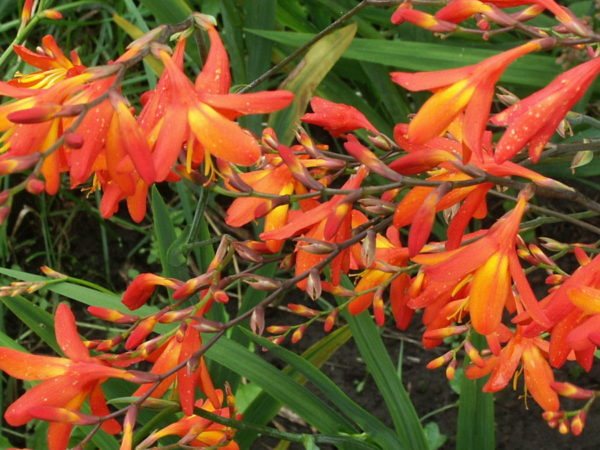

How and when to collect seeds
Many novice gardeners often make the same mistake when trying to breed montbrecia by collecting seeds. If you already have this plant on your site, then it is best to dig up the children and plant them. In the case of seed collection, there are a number of difficulties.
Montbrecia seeds can only be harvested after they are dry.
First, they must be sufficiently ripe and dry. The optimal time for collecting seed is the end of September. But in our climatic conditions it is difficult to meet the necessary conditions, and the seed pods can simply be devastated by the wind.
Secondly, the germination of the harvested seeds is extremely low.Of ten seeds, no more than two usually germinate, and their further fate is in jeopardy.
Therefore, it is best to purchase seeds from the store, and then propagate the plant with tubers.
Possible difficulties
There may be some difficulties in growing crocosmia. Most often, there is a condition such as rotting of the bulbs. The reason for this condition is the stagnation of moisture in the soil, as well as the low temperature of the soil.
If the montbrecia does not bloom for a long time, the reason for this condition is most often a small amount of sunlight or a bust with fertilizing with minerals.
With the yellowing and wilting of the plant, waterlogging of the soil and high air temperature should be excluded. In addition, this condition may be due to the natural process of transition to wintering.
Planting a montbrecia from bulbs
Chinese gladioli grow well from bulbs, which must be brought into the house before planting and separated from overgrown children. To make the bulb more hardy, it must be treated with a solution of potassium permanganate immediately before planting in the ground.
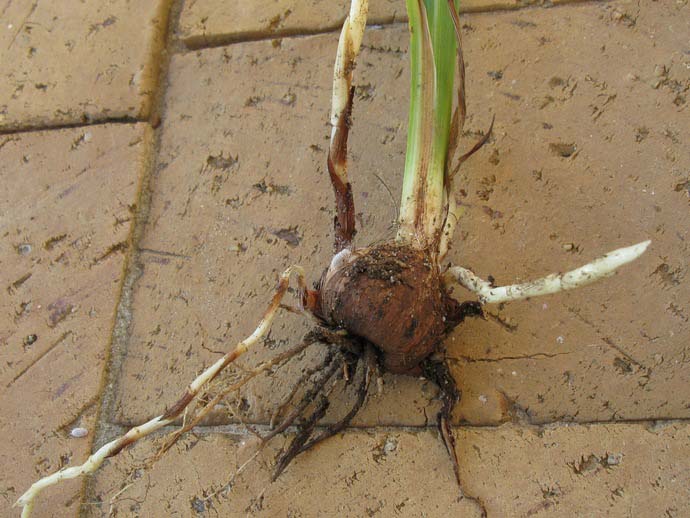

The soil for montbrecia should be loose, well fertilized with organic or mineral components. A place for planting flowers can be prepared in the fall, using sand for drainage. If desired, the soil can be neutralized from possible pathogens by treating it with a solution of potassium permanganate.
The distance from one bulb to another should be at least 10 cm. The holes can be made with a shovel or a hoe, their depth should be about 4 cm. In order for the montbrecia to bloom earlier, it is better to germinate the bulb in special containers before planting. It is necessary to plant sprouted bulbs together with the soil that is in the pot.
Despite the similarity of the plant in the name and shape of the bulbs with the gladiolus, the montbrecia is much better than its well-known relative, since it is distinguished by greater endurance and unpretentiousness in care.
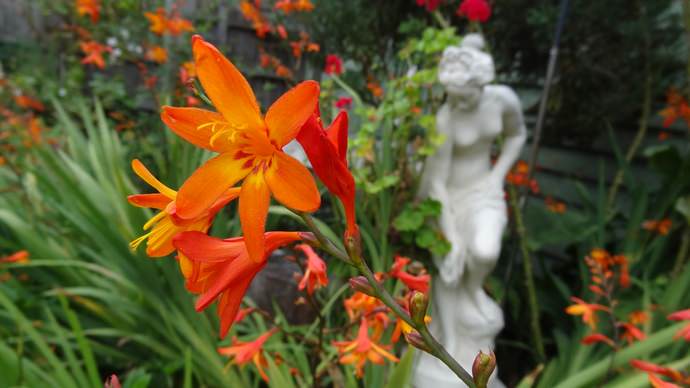

She does not require as thorough watering as a regular gladiolus and does not need frequent feeding.
Chinese gladiolus is suitable for decorating large and small flower beds. It can be grown with any other flowers - chrysanthemums, echinacea, cannes, dahlias, daylilies, where gladiolus will complement these wonderful plants and help create a unique composition in the garden.
Before buying a Chinese gladiolus, you should carefully read about the variety itself (and there are quite a few of them), since some plants can reach a height of more than 1 meter (for example, the Montbrecia Lucifer variety, which is distinguished not only by its tallness, but also by its rich red flowers). This will require planting them not in small flower beds, where stunted ones are suitable, but for large areas or to decorate hedges. The largest flowers are in the Star of the East variety, where the bud exceeds 9 cm in diameter.
Characteristic features of the plant
Despite belonging to the Iris family, the montbrecia outwardly resembles a miniature gladiolus. Narrow pointed leaves of a xiphoid shape are collected in a basal rosette. Thin flower stalks rise above them, reaching a height of 1.5 m. In late June-early July, the first buds appear on them. They bloom alternately, giving the plant an attractive appearance throughout the entire flowering period (July to September).
- Clairvoyant Baba Nina named the signs of the zodiac, on which money will fall from the sky in May 2018 ...
►
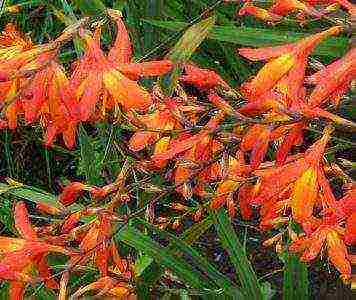

4-5 colors similar to stars are revealed at the same time. They can be colored pink, white, golden yellow, juicy orange or scarlet. The diameter of the flowers reaches 5 cm. They are collected in dense paniculate inflorescences.
For its resemblance to the gladiolus, the montbrecia is called the Japanese (or Chinese) gladiolus. The plant is a bulbous hybrid obtained by crossing the Potts crocosmia and golden crocosmia. Flowers are native to South Africa.
The montbrecia has small flattened corms, similar to the roots of gladiolus. Their diameter is about 2-2.5 cm. The corms are covered with several layers of reticular membranes. During the warm period, several new replacement bulbs develop.
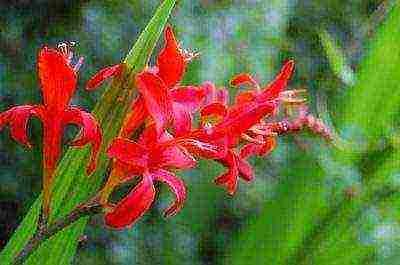

Plant care is not much different from the conventional gladiolus agricultural technology. Its corms are also recommended to be dug up and stored indoors during the winter under certain conditions.
The best varieties
Golden Montbrecia
This type of plant reaches a height of one meter, is distinguished by remarkable thick and decorative leaves. The flowers are golden yellow in color, about 5 cm in diameter.
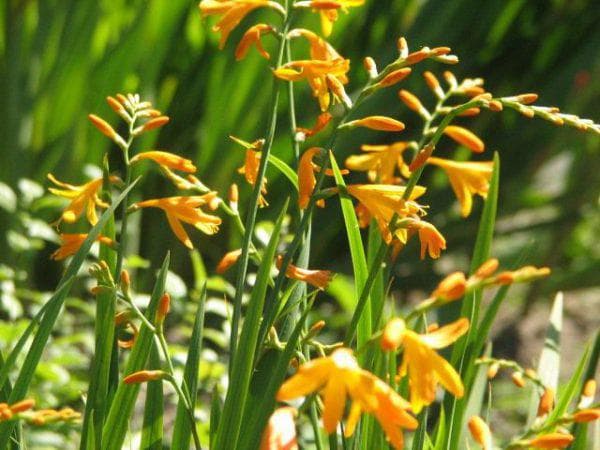

Golden Montbrecia
This type of crocosmia is recommended to be grown in shaded areas of the garden, since in nature it grows in tropical forests. It blooms in autumn, and usually wonderful inflorescences are used to compose group bouquets. But how the landing and leaving of the Golden Tui takes place is described in this article.
Montbrecia Massonorum
This type of plant can reach a height of 80 cm, is distinguished by large bulbs, and interestingly shaped leaves. The flowering of this type of crocosmia is very long, but the flowers themselves have a small diameter.
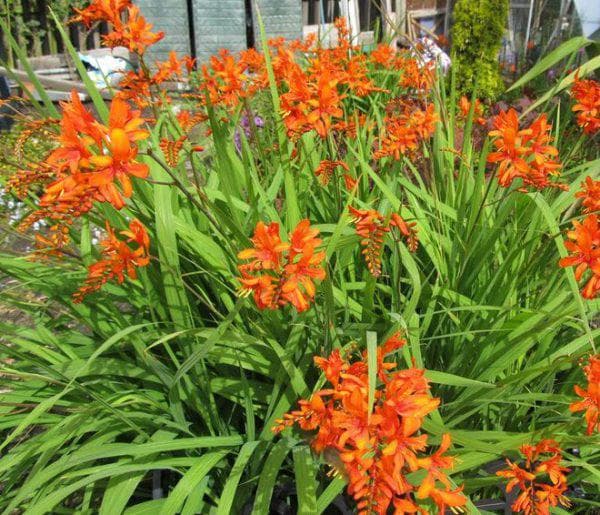

Montbrecia Massonorum
Montbrecia Lent
This is the most unassuming type of plant: the Post montbrecia is able to survive even under the most unfavorable external circumstances. The plant has long narrow leaves and small, but very decorative, flowers.
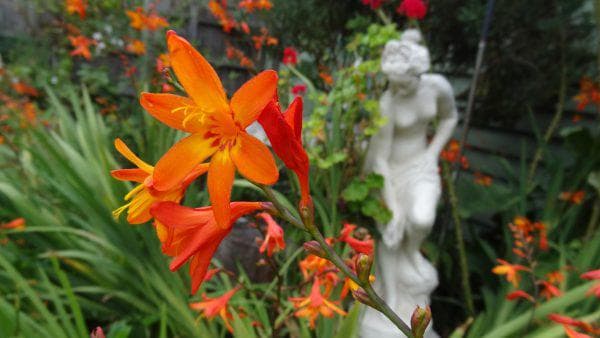

Fasting
Montbrecia Panicula
This type of crocosmia begins to bloom in early summer, and continues until frost. Its leaves are corrugated, and the plant itself can even safely survive slight frosts.
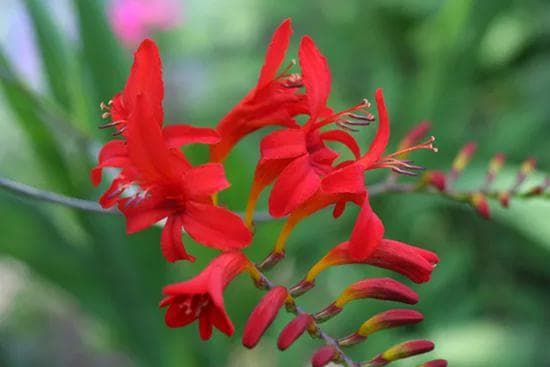

Montbrecia Panicula
Montbrecia Lucifer
It is one of the most popular hybrid crocosmia varieties. The variety has a wide variety of colors, which makes it possible to decorate the garden in the most picturesque way. It is widely used in landscape design for flower beds, flower beds, as well as for creating picturesque garden compositions.
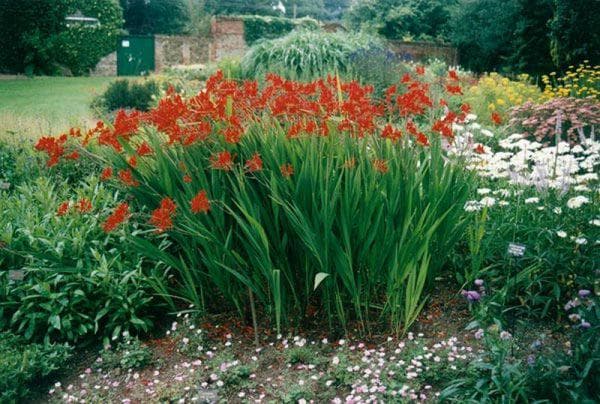

Lucifer
A mix of different varieties of crocosmia is also often planted, which is a particularly picturesque sight. But how to make a plastic flower bed for your garden, this information will help you understand.
The video shows everything about the landing of Montbrecia:
Japanese gladioli - unpretentious flowers in the garden
Plant height up to 75 cm, flowers up to 5 cm in diameter.
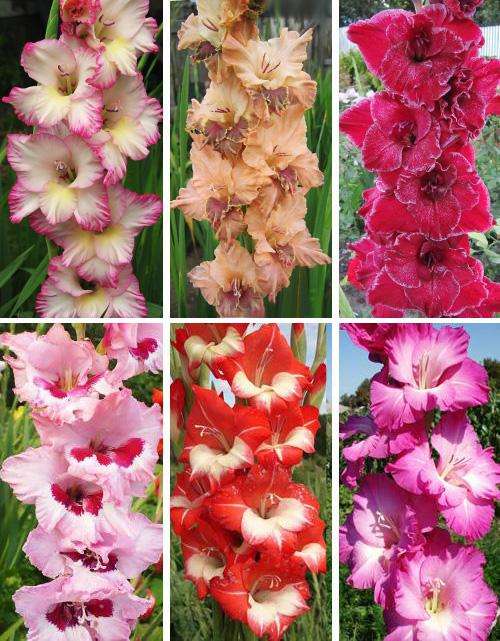

How to grow crocosmia from seeds?


Montbrencia can be propagated by seeds and corms. If you choose the first option, you need to plant only seedlings in open ground, since it is not a fact that seeds will germinate in such conditions. In late February and early March, the planting material is placed in water and changed every 6 hours. Then sowing is carried out in a soil mixture, which includes grain soil, humus, peat and sand. The planting must be covered with foil and placed in a lighted place.
How to care for seedlings?
The procedures required at this time are familiar to all gardeners. When seedlings appear, they remove the film from them and do the same as with other seedlings: water the plants when necessary and loosen the ground around them. It is always advisable to leave the substrate moist, but not flooded with water, otherwise the sprouts can become infected with fungi.
When the second and third true leaves develop, the seedlings are placed in larger containers so that they can grow well before planting in an open space. 14 days before transplanting, you need to gradually take out the seedlings to the air. This procedure should take longer and longer every day.
Planting crocosmia in the ground
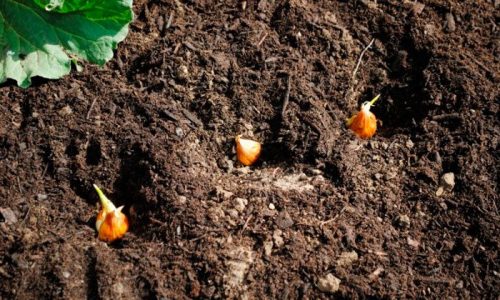

Tritonia is placed in open soil in late April - early May, when the soil warms up to 6-10 degrees.It is necessary to plant a flower only in a lighted area in order to be able to see its flowering.
The soil must be permeable, but it is bad if the groundwater is close to the surface. The hybrid does not tolerate moisture accumulation near the roots.
A flowerbed for a plant is prepared in the fall: for each square meter, add 2 buckets of humus, 10 g of slaked lime, 20 g of potassium chloride, 40 g of superphosphate. Before planting the montbrecenium in the soil, nitrogen-containing fertilizers are applied there.
Seedlings are immersed in holes at a distance of 10-12 cm from each other. The distance between the rows should be 25-30 cm. Crocosmia planted on a flower bed should be watered and protected from too active rays of the sun for 2-3 days.
As a rule, the "seed" plant blooms in the 3rd year. But if you create an ideal environment for a hybrid, it can please with flowers already on the 2nd.
Winter storage of corms in an earthen prikop
author Kiryanova L.K., photo by the author
Bulbs and corms of thermophilic garden plants that do not survive frosty winters, gardeners of the middle lane have to dig up annually in the fall. Then it is important to properly lay the planting material for winter storage in order to plant it again in the garden in the spring at the optimum time.
After the autumn digging of the overgrown nests of bulbs and corms, they are taken apart. Then the slightly dried planting material is usually placed in slightly damp peat, sand, moss or sawdust to avoid drying out during the storage period.
It is necessary to maintain optimal storage conditions for bulbs and corms of heat-loving plants of different types. If the planting material needs to be kept cool until the next planting, then for this purpose gardeners usually use a household refrigerator, basement, cellar or garden air-dry hole.
I want to share with the readers of the site a simple storage method that I use for wintering corms of montbrecia in an earthen pond. I have been doing this for several years now, and the storage results are always successful!
Growing conditions
The Japanese gladiolus feels comfortable in loose, well-drained, humus-rich soil.
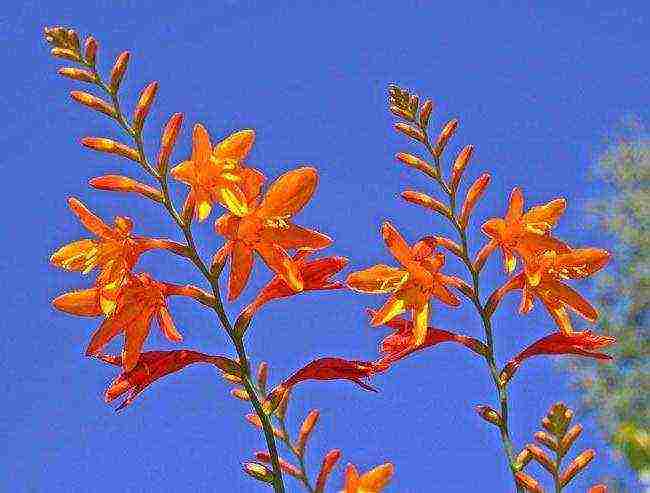

It is advisable to choose a place for landing that is well-lit, without drafts and sunshine on a summer afternoon. You should not plant the montbrecia in the shade, otherwise the plant will begin to stretch and will not bloom at all.
Since the fall, the site on which it is planned to grow Japanese gladiolus needs to be prepared by adding organic fertilizers to the soil in combination with slaked lime and superphosphate. Before budding, and then every 2-3 weeks, Japanese gladiolus, the cultivation of which is not too troublesome, is recommended to be fed with mineral fertilizers.
Preparation of planting material for storage
Montbrecia, especially its large-flowered varieties and hybrids, winter problematic in the gardens of regions with harsh winters.
In the fall, before the cold weather, I dig up the nests of montbrecia. Immediately, I disassemble the overgrown nests into separate corms. (By the way, you can bury the whole nests in the garden for winter storage in the fall without disassembling them first. You can do this in the spring, just before planting. But in the spring, in my opinion, there is always more work, and the planting dates are very tight. Therefore, I share the excavated nests of corms in the fall).
After parsing the dug nests, I throw out the old corms, and cut off the leaves from the young ones. I put the corms prepared for storage in a bag. For this purpose, I use a granulated sugar bag (only without film!), Since it does not rot in the ground and is good for air permeability.
The origin and appearance of the plant
Montbrecia appeared thanks to the works of the French breeder V. Lemoine. In 1880, he crossed the Potts crocosmia and the golden one, as a result of which a magnificent garden hybrid was obtained. In Latin, the flower is called Crocosmia.
The plant has been widely used in decorative floriculture for more than a century. It is used to create landscape compositions, decorate terraces and balconies. The Iris family, to which the crocosmia belongs, is very popular among both experienced and novice florists.
Crocosmia in height reaches from 40 cm to 1 m. Leaves are thin and long, corrugated structure, arranged in small bunches. Spike-shaped inflorescences are located closer to the top of the stem. On one stem, there are on average about 40 flowers, which begin to open from the lower inflorescences.
For your information! Depending on the variety of crocosmia flower, the color of the petals differs. It ranges from pale yellow to bright red. There are also red-brown flowers. When opened, the flowers reach 5 cm in diameter, and their shape resembles a lily.
Description of the Irisov family
The Iris family has about 1800 plant species belonging to 75-80 genera. The most common representatives are juno, irises, herododictiums, gladioli, acidants and crocosmias. Representatives of the family grow almost all over the world. It is difficult to find botanical gardens without these plants, which combine only herbaceous perennials.
Representatives of Iris differ in iris leaves with a two-row arrangement and a xiphoid, crescent or ribbon-like shape. Flowers are collected in paniculate and racemose inflorescences. Pollinated mainly by insects, but there are species pollinated by birds.
Note! The popularity and demand for the flowers of this family are explained by their decorative and attractive appearance. In addition, the rhizomes of some species have medicinal properties, and the essential oil of iris contains valuable alkaloids.
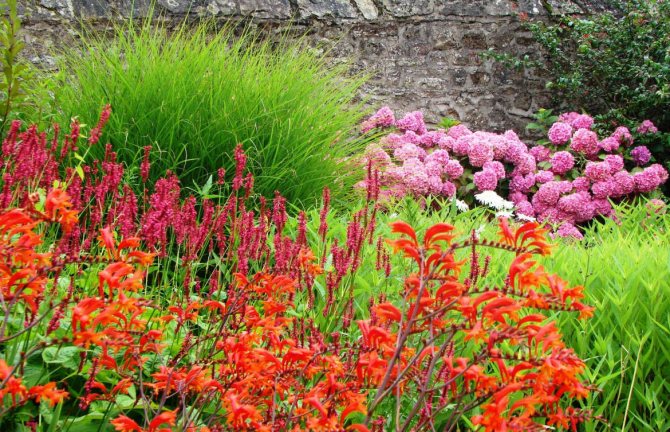

Crocosmia in the garden
Crocosmia perennial
An attractive, bright flower with an unusual name for perennial crocosmia is perfect for decorating a summer-autumn flower garden. Its lush, bright orange blossoms are effectively combined with narrow, bright green foliage. The flower is distinguished not only by its expressive, but also by its long flowering, which lasts until autumn.
During flowering, the flower exudes a pleasant aroma reminiscent of the scent of saffron. It even persists after the plant has dried.
As for the reproduction of the Crocosmia flower, it is carried out by vegetative or seed methods. In order to get a formed plant by the spring, it is necessary to sow it for seedlings in advance. Therefore, reproduction by dividing the corms is recognized as the most convenient.
The flowering period of perennial crocosmia lasts from July to September, some varieties bloom until the first frost.
Note! The flower is not afraid of high temperatures, but the lighting is very demanding. With a lack of light, the plant stretches out and may not bloom at all.
Montbrecia in a bouquet
When creating a bouquet with Montbrecia, it is good to add a golden color to it, for example, cereals. They will make the flower look even more graceful and sophisticated. In a bouquet, Montbrecia can withstand up to 4 weeks. During this period, she will fully open her buds to the world. Cutting off Japanese gladiolus for a bouquet is very beneficial for the further growth of flower bulbs. Those who do not want to part with a beautiful flower can be advised to dry it for a dry bouquet for the winter. It will preserve the color and shape of the flowers.
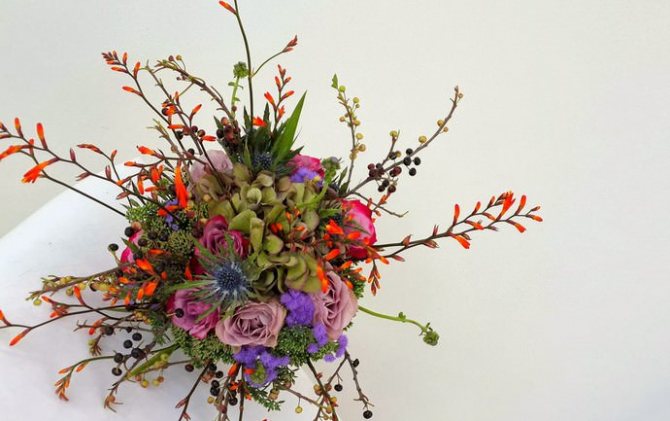

Preparation for wintering
Usually winter in the Moscow region is accompanied by severe frosts, so it is better to dig up the montbrecia bulbs. This procedure should be performed in mid-October and later. It is not worth digging the bulbs earlier than the specified period, since the children will not have time to form for independent growth. The bulbs should be well dried and placed in boxes filled with peat or paper bags.Then take them to the cellar or refrigerator, not allowing the temperature to drop below 5 ° C and rise above 10 ° C.
Tags: bulbous
Planting crocosmia in open ground
Placing sprouts in an open space is a fairly simple procedure that does not require special conditions. For optimal development of the montbrecia, it is important to determine the normal planting time and find a comfortable place for the flower.
What time to plant
Planting bulbs or seedlings is carried out in mid-spring when the soil warms up to normal temperature. For good development and long-term preservation of crocosmia flowers, seedlings or bulbs are planted in an open place, protected from drafts, which receives a large amount of natural light. These conditions must be fulfilled, since crocosmia will not bloom under other conditions.
Since the soil warms up at different rates in certain regions, the timing of planting crocosmia bulbs and seedlings may shift in different directions. The optimal time for planting is the period when the soil temperature has become about 10 degrees; weather conditions do not promise further frosts and prolonged rains.
Choosing a landing site
The best place for crocosmia planting is a well-ventilated open area, protected from strong winds. For the appearance of flowers on crocosmia and the duration of flowering, the bulbs and sprouts are planted in sunny places with a lot of light.
The landing site is selected in advance. Crocosmia thrives on the southern sides of the flower beds or the southeastern parts of the nursery. In addition, great importance is attached to the condition of the soil. The soil at the site of the proposed planting of tritonia must be well drained and permeable to water.
The soil for tritonia is prepared in the autumn. To do this, after removing the bulbs from the ground for wintering, the soil is carefully dug up, removing weeds with roots. During digging, organic fertilizers, humus and potassium chloride are applied. In the spring, just before planting, nitrogenous fertilizing is introduced into the substrate and the substrate is loosened again.
Since the flowers cannot withstand stagnant water, planting holes are prepared in advance. To do this, dig holes up to 30 cm deep. A layer of drainage - sand is placed on the bottom of each hole. After that, a layer of peat mixture is poured into the hole, which is necessary for optimal growth of crocosmia.
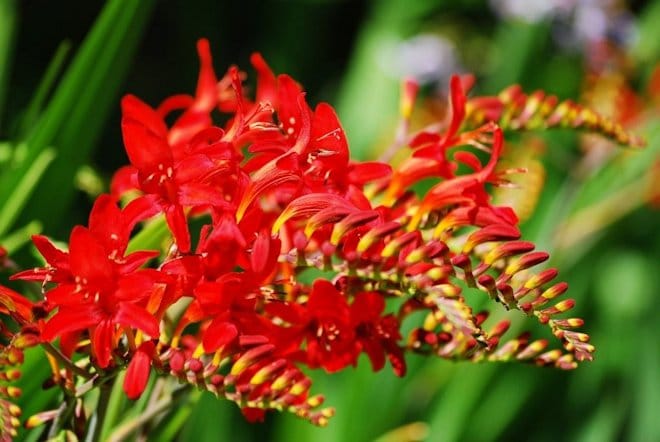

How to plant
Planting of young seedlings and bulbs is carried out with a distance of about 15 cm between individuals. A break of 30-40 cm is observed between the rows. When the seedlings are placed in the soil, planting is carried out together with the remains of the soil on the roots of the seedlings. Planted individuals are watered with a small amount of water. Immediately after planting, young shoots are sheltered from the sun for several days using bottles or film.
The plant obtained from seeds, under comfortable conditions of growth and care, begins to bloom only in the third year after germination. During this time, the bulb is fully formed, begins to give birth to children. However, when creating comfortable conditions, the plant can bloom as early as the second year after emerging from the seeds.
Spread
In its natural environment, the plant appeared at the end of the 19th century in southern Africa and France. The plant prefers to grow in warm, sunny places, therefore it is often found in the southern regions of America, East Asia and in the south of Russia. In Russia, crocosmia grows in the Krasnodar Territory and Simferopol. Found in the Caucasus and the Far East
The plant predominates in arid regions with a subtropical climate. The cultivation of decorative varieties is possible in open flower beds of a temperate climate, therefore, when optimal conditions are created, it is possible to grow montbrecia in any climate. Tritonia is quite well adjacent to other plants in the flower bed, so it can be grown in the open field.
Planting and storing bulbs
Montbrecia bulbs are planted in April-May to a depth of 6-10 cm with an interval between plants of 10 to 12 cm.In the still rather cool ground, the Japanese gladiolus will first form a root system, and as the soil warms up, it will actively begin to build up the aboveground part. When planted at a later date, the flower will immediately grow and will not have time to acquire good roots, which will negatively affect its appearance. The bulbs are dug up.
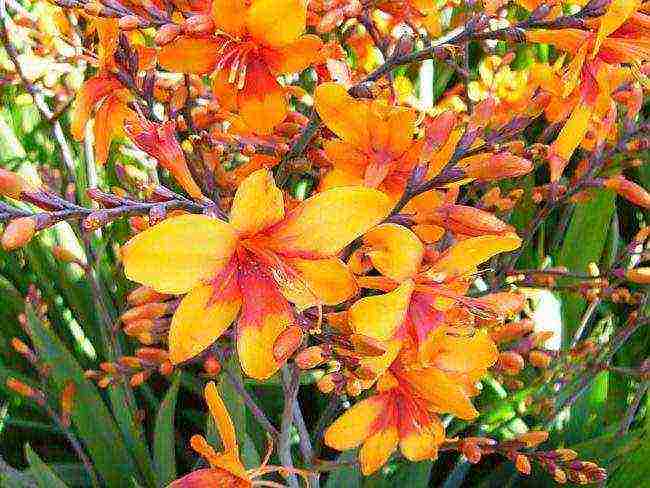

After digging out the bulbs, which is required after the leaves turn yellow (at the end of September-October), the stem is carefully trimmed, leaving 5 cm of its length at the root. Then the bulbs with children should be dried in a cool room (cellar or basement) at a temperature of 6-8 ° C for 1-2 weeks, folded in containers with dry peat, moss or sawdust. Before the spring planting, carried out in March, the bulbs are recommended to be kept at room temperature for several days, after which preparatory actions such as separating the children, peeling off the husks, pruning the roots and the remnants of the shoot are performed. Before planting, the bulbs should be kept in a light solution of potassium permanganate for several hours. The plant must be planted in containers, and in May, transplanted to a permanent place of growth in open ground.
Crocosmia: photos
Laying corms for storage in an earthen pit
I put a tied bag with corms in the dug hole and bury it.
After filling the storage pit on the compacted soil, I put an old basin or something else on top that will help prevent water from penetrating into the ground above the planting material laid for storage. At the same time, this shelter serves as a mark of the place where I buried the corms.
In April and early May, I dig a bag out of the ground. In it I find remarkably overwintered strong corms of montbrecia, already slightly sprouted. Planting the montbrecia in the garden again.
I am glad that my experience of winter storage of montbrecia corms in an earthen pond will be useful to other growers!
I have not yet tried to store heat-loving plants of other types in the garden in this way.
Lyubov Kiryanova (Moscow region, Podolsk district) "Floriculture: Pleasure and Benefit"
All about montbrecia
Online All about bulbous
Online All about plant storage
Online All about wintering plants
Online
Fertilizing and feeding crocosmia
In the phase of the appearance of leaves, the first feeding of the montbrecia bushes is carried out. Complete mineral fertilizer is applied to plant beds. You can water the plantings with infusion of cow dung or bird droppings. It is necessary to repeat the fertilization of the bushes at least 3 times a month.
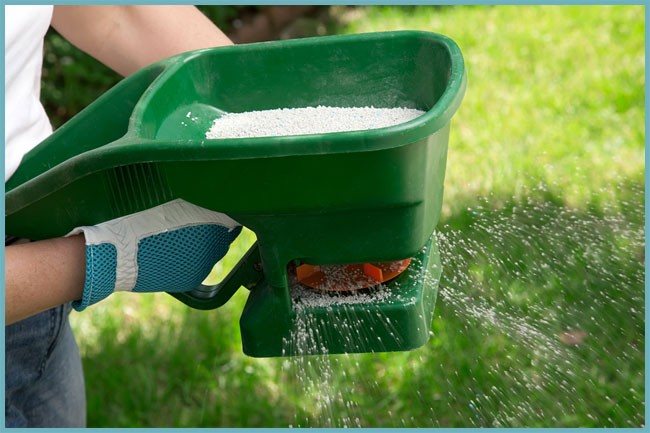

Crocosmia needs quite frequent mineral dressings
Closer to autumn, the plant must be fed with potash fertilizers. This top dressing will strengthen the corms and better transfer the wintering of plants.
Wild gladioli
- Ordinary... The total height of the plant is up to 60 cm, the length of the inflorescence is up to 18 cm. The flowers are pink, red. There are up to 12 flowers on the inflorescence, with a diameter of 4 cm.
- Swamp... The stems of the plant are thin, rather weak. The total height reaches 50 cm, the inflorescences are pink.
- Byzantine... The total height of the plant is up to 45 cm. The color of the inflorescences is violet-pink, burgundy-pink. The inflorescence consists of 5 flowers.
- Turkmen... The total plant height is up to 80 cm, inflorescences are crimson, pink.
- Primrose... Plant height up to 80 cm, pink-red inflorescences.
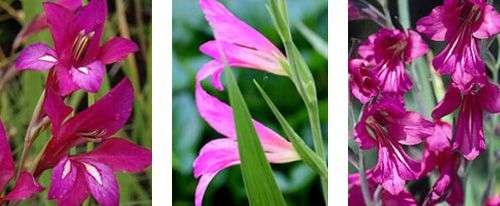

Care features
The flower needs to be provided with moderate root watering throughout its life cycle. It is enough to water the flower 1-2 times a week. If it rains systematically, then watering stops.
Top dressing
If the soil has been properly fertilized before planting, then there is no need for frequent fertilizing. If not, then fertilizer should be applied systematically, every 10 days. During the budding period, to stimulate flowering, fertilizing is needed to saturate the plant with potassium.If everything is done correctly, then the flower will surely thank its owner with a spectacular appearance and a pleasant aroma.
Preparing for winter
In regions where the air temperature drops below -20 ° C, according to the general description of the plant, the bulbs must be removed from the soil in autumn. This is done around the beginning of October. After digging, they are dried and placed in a cool, ventilated place with an air temperature of about 10 ° C.
Important! In regions with warm winters, flower bulbs do not need to be dug up. It is enough to cover it with a mulch layer and cover it with cling film on top.
Frost-resistant varieties of montbrecia (crocosmia)
Small-flowered varieties are the most resistant to frost during cultivation. With appropriate insulation, they can overwinter in the ground. The most popular varieties that can normally survive frost at -30 degrees: Lucifer, montbrecia Mason, Emily McKenzie... Moreover, in the first year after planting, the bushes of the Japanese gladiolus, even frost-resistant varieties, are carefully covered for the cold period. Crocosmia hibernating in the ground blooms much earlier and is distinguished by larger inflorescences. The varieties are weakly frost-resistant His majesty and Star of the east.
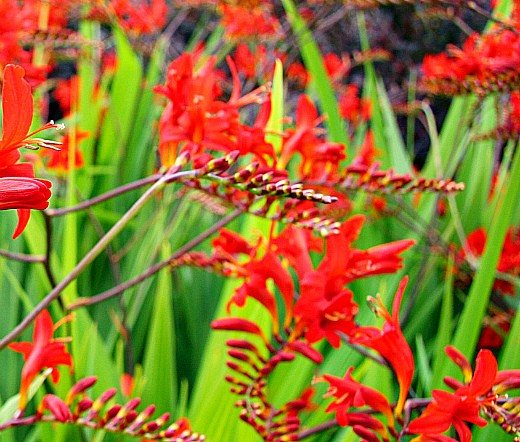

Application in landscape design
Feedback from experienced gardeners suggests that planting Japanese gladioli in a group looks more impressive than a single one. It is especially beautiful when they are planted in rows - they grow luxuriantly and densely, bloom profusely. They are often planted in groups in parks in flower beds. As you can see in the photo, the inflorescences of the Japanese gladiolus are suitable for creating flower arrangements. They go well with ornamental herbs, salvia, echinacea, dahlia, cnifophya, rudbeckia, yarrow and cereals.
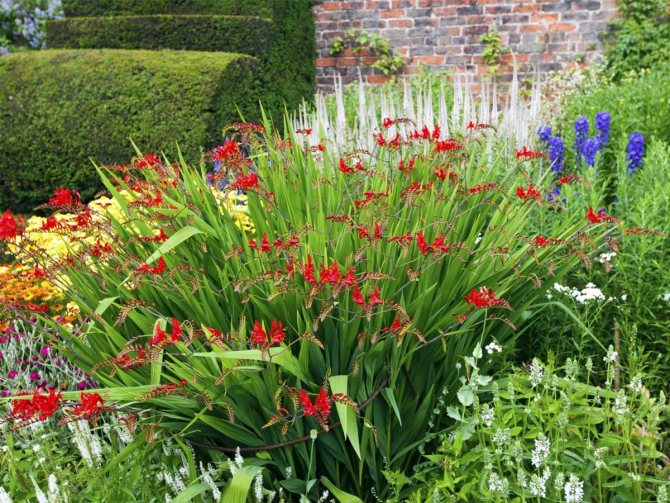

Photo:
The montbrecia looks good along the garden paths, here it can be very successfully combined with undersized flowers. Gladiolus is also planted near ponds and gazebos. Planting and caring for the Japanese gladiolus is simple, and you get a lot of beauty from it. That is why the flower is becoming more and more popular every year. And if you are just thinking about what else to decorate your summer cottage, give this plant unconditional preference.
Reproduction of crocosmia
Montbrecia can reproduce in two ways - seed and vegetative. Seed propagation is used when growers first decide to plant a flower in a flower bed and buy a certain species in the form of seeds. In other cases, propagation using bulbs is more often used.
For seed breeding, large ripe crocosmia seeds are used. When ripe, the seeds are brown in color, the seed size reaches 3 mm. Reproduction by tubers occurs in the spring, when children are separated from an adult and planted in a separate place of growth.

